Unthinkable
One of the most interesting Doctor Doom stories may also be the most controversial moment in Doom’s history. The centerpiece story arc of Mark Waid’s Fantastic Four run, “Unthinkable,” has either enraged or elated fans of the Fantastic Four since it’s release in 2003.
In the first issue of this story, Doom quests to find his former girlfriend, Valeria.
At the story’s open, Doom says to a palm reader…
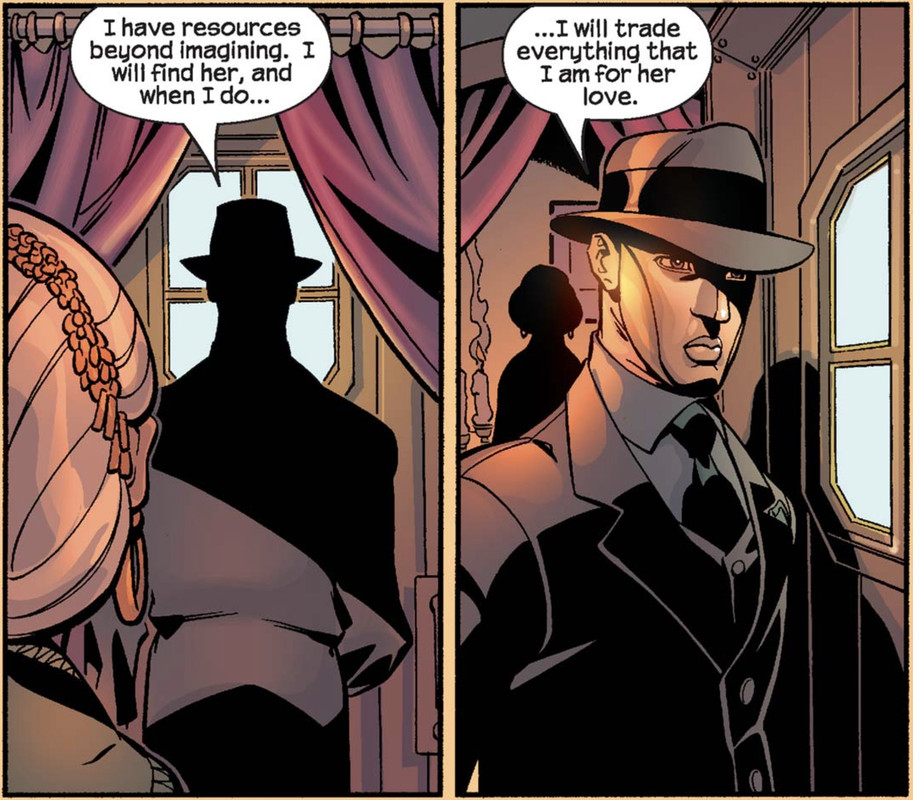
Doom keeps his word. Doom will be the first to tell you of his honesty. In comics history, we have seen one thing to be true time and time again. Doom never lies.
Promising Valeria that her love will make him a changed man, Doom convinces her to offer him a second chance.

In what is perhaps the most controversial development in Fantastic Four history, Doom had ulterior motives. Valeria’s love was a stipulation of a demonic deal Doom had made with the underworld. Now that she has confessed that she believes in Doom, he is empowered to fashion her skin into a mystical armor that he will use to defeat the Fantastic Four, killing the woman he claims to love.
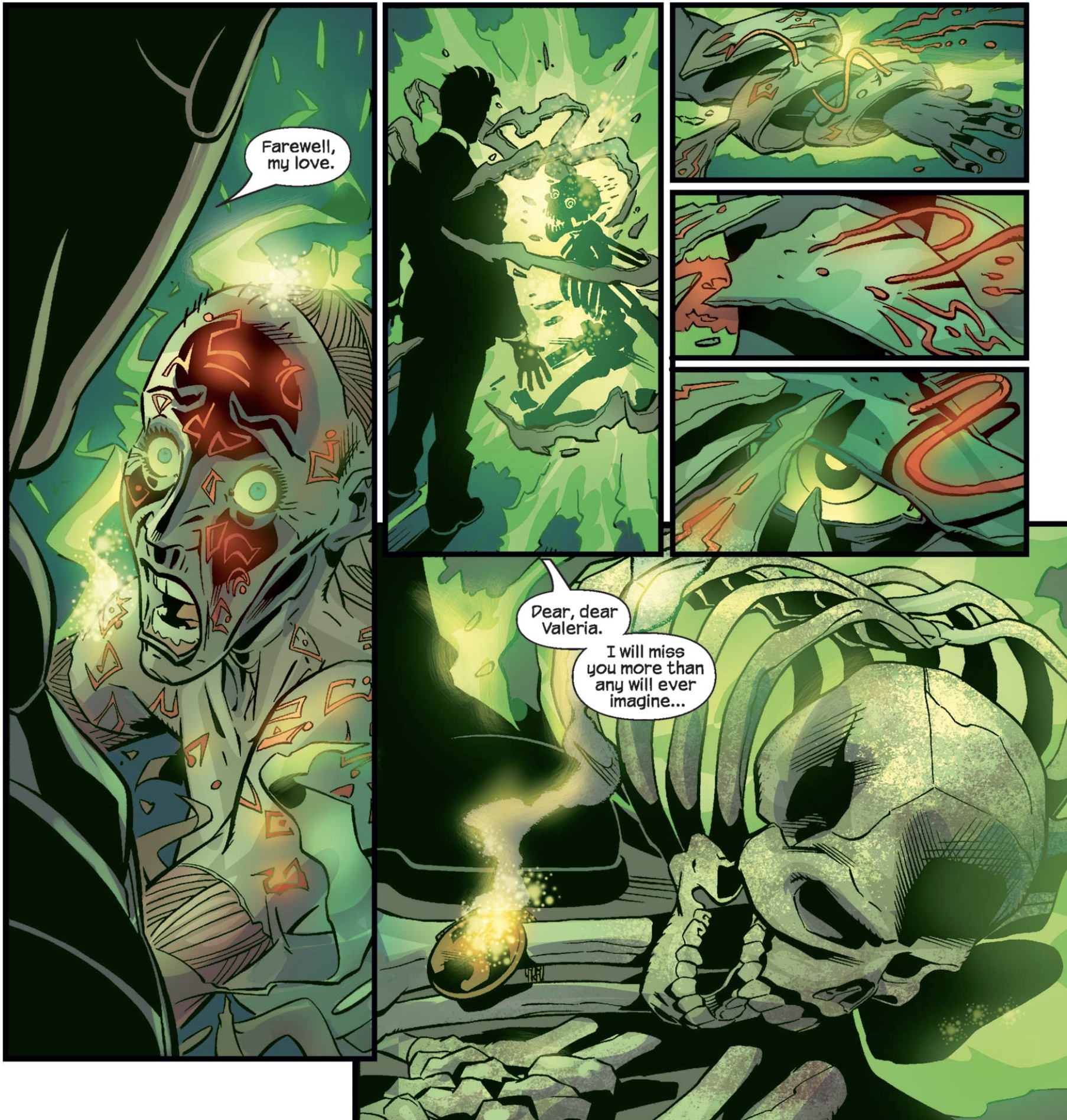
At this point headlines such as…
“Doctor Doom Isn’t Just Marvel’s Best Villain, He’s Their Best Hero Too”
Francesco Cacciatore, “Screenrant” article
Seem to make very little sense.
If Doom is secretly Marvel’s greatest hero how can he be capable of such evil? His motivations in this story aren’t noble, he simply means to best Reed Richards (Mister Fantastic) to boost his own ego and vanity.
So why do some see Doom as a hero, and why might he be Marvel’s most devious villain?
A Fantastic Rivalry
Doom’s hatred of Reed began while they were studying together at “State University.” Doom had been secretly plotting an experiment to rescue his mother’s damned soul from the underworld. Using a mixture of science and magic, Doom built a demonic dastardly device, but before its first trial run, Reed Richards happened to stumble upon some of Doom’s calculations…
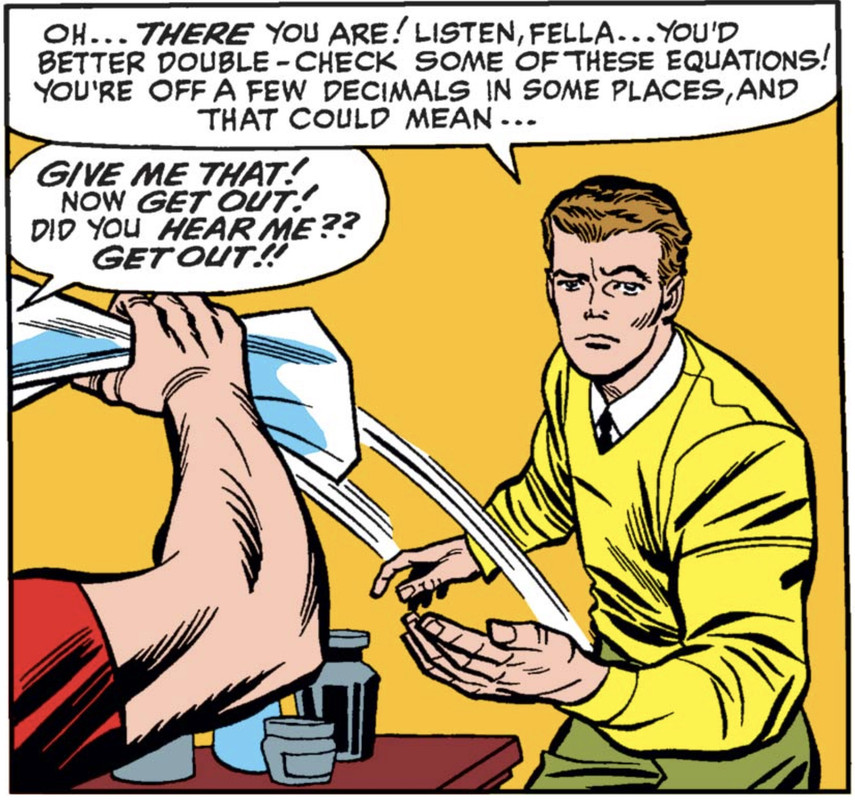
Doom finds the idea that he is capable of error laughable, and proceeds with his experiment regardless.
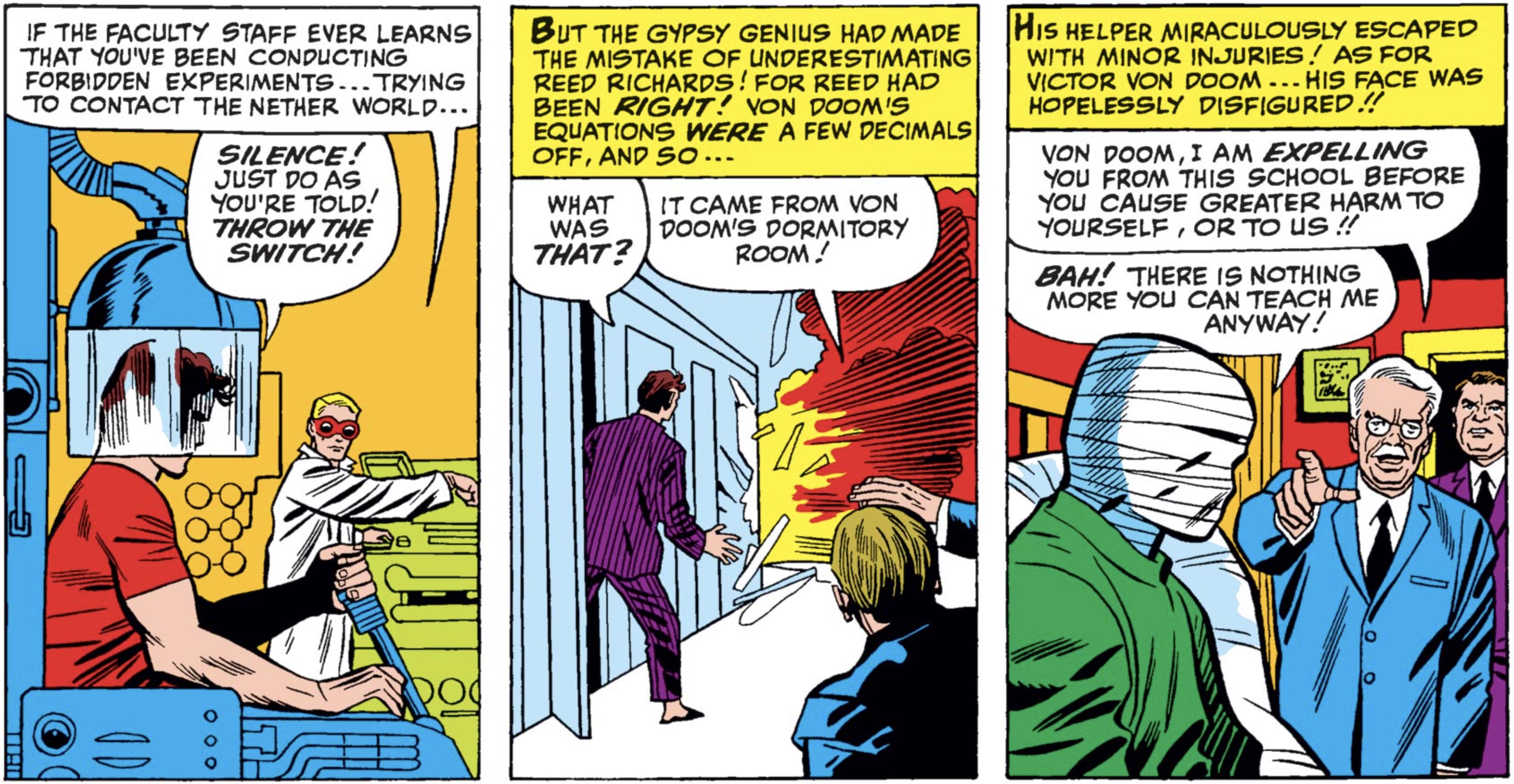
The experiment fails with the narrator revealing Richards had identified an error within Doom’s math. The resulting explosion leaves Doom’s face scarred and gets him expelled from University.
Doom, refusing to accept any internal faults, believes that Richards, fueled by a jealous rage, obviously sparked by Doom’s superior intelligence, tampered with his machine.
Doom journeys to the Himalayas, keeping his face hidden in bandages. There, he studies magic with a village of monks, quickly becoming their master. With the monks, Doom designs his armor and hastily applies his mask, covering his horrible disfigurement from the lab accident.
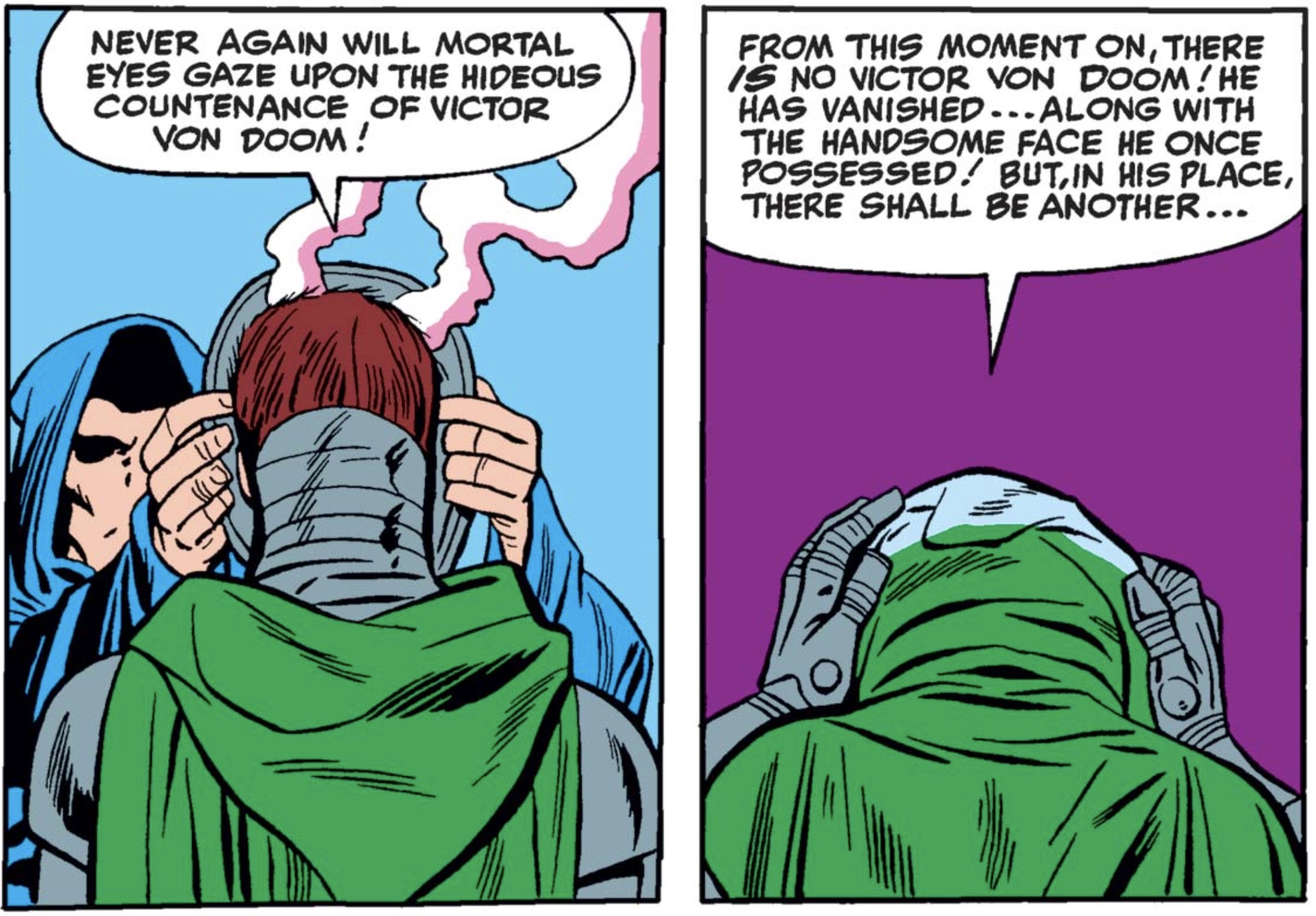
In “Unthinkable,” Doom murders his former girlfriend, solely to gain the upper hand in his upcoming assault on the superteam of his archenemy, the Fantastic Four. What could cause a man to commit an act so violent? So despicable? So unthinkable? Doom is an undeniable genius, and somehow he is incapable of seeing the truth that is right in front of him: he was wrong, he is responsible for his own scarring. Doom imagines that Reed is responsible for his ghastly appearance. Reed has encased Doom in a metal prison, from which he can never escape.
I think “Doom the Noble” would tear the head off a newborn baby and eat it like an apple while his mother watched if it would somehow prove he were smarter than Reed.
Mark Waid, Fantastic Four Writer 2002-2005
Reed’s innocence is obvious, and Doom is smart enough that he must see that too, although he could never admit it.
Parallels
Doom is a portrait of ego gone haywire. A tragic figure of self-loathing hidden beneath bravado and theatricality. He refers to himself often in the third person, not because he doesn’t understand commonsense grammatical norms, but because he believes he has earned that level of grandiosity. But what makes him such a great foil for the Fantastic Four?
An important similarity can be found in the origin of the Fantastic Four. Reed Richards prematurely launches his friends into a space, despite the protests of Ben Grimm, exposing them to a disastrous dose of cosmic rays giving each of them fantastic abilities.
Doom, instead of venturing into the heavens, attempts to brave the underworld. Similarly, Doom’s experiment has disastrous consequences.
Both Doom and the Fantastic Four gain their powers from a scientific experiment, activated too early due to the hubris of their respective scientists.
Reed learns humility from his mistake, and feels remorse for turning his friends into superheroes.
In turn, Reed forms a found family and learns to rely on others for emotional support and feedback.
Doom returns to his home country of Latveria and, through a violent coup, installs himself as monarch, silencing dissenting opinions, and further isolating himself.
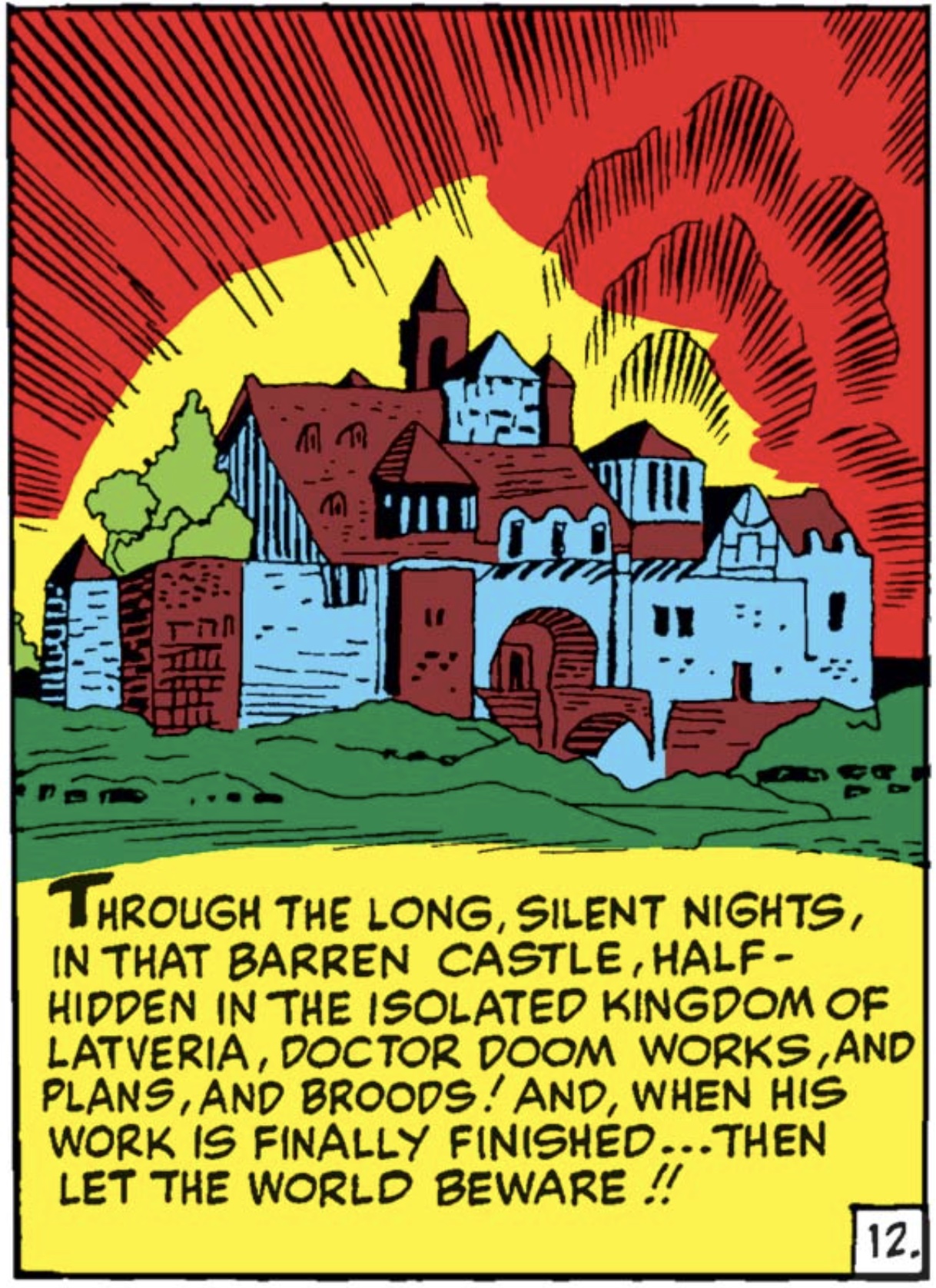
The Face of Doom
Doom’s accident famously scarred him beyond belief. Just look at this panel of Dr. Donald Blake reacting to Doom’s face.
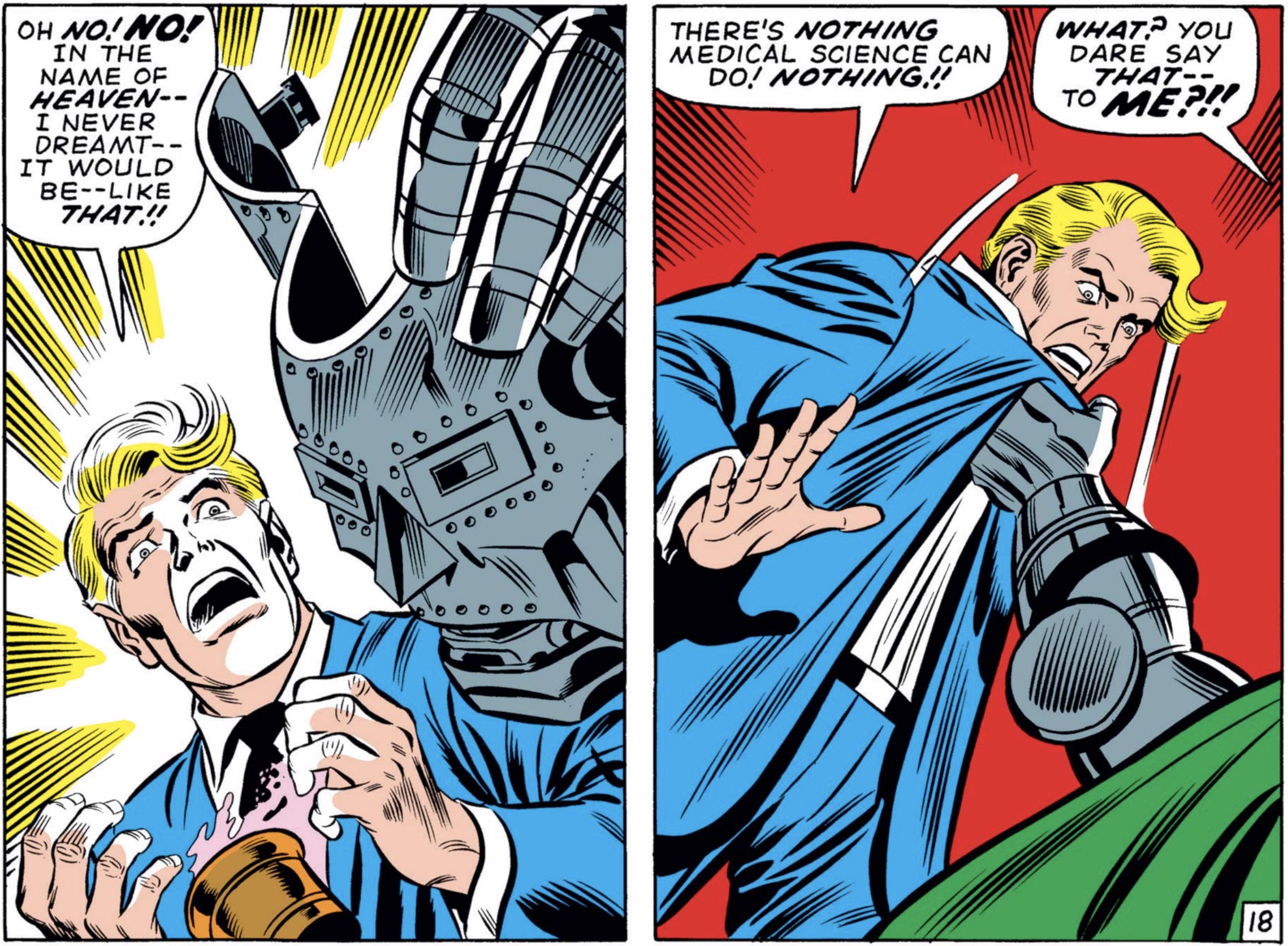
Ever heard of bedside manner, doc?
While Doom’s face wasn’t shown in the comics after his accident, Jack Kirby, Doom’s co-creator, would go on to draw an image of maskless Doom, featuring only a small scar.
(This image is not a part of published Marvel canon, Kirby was just sketching a Doctor Doom while voicing his thoughts on the character.)
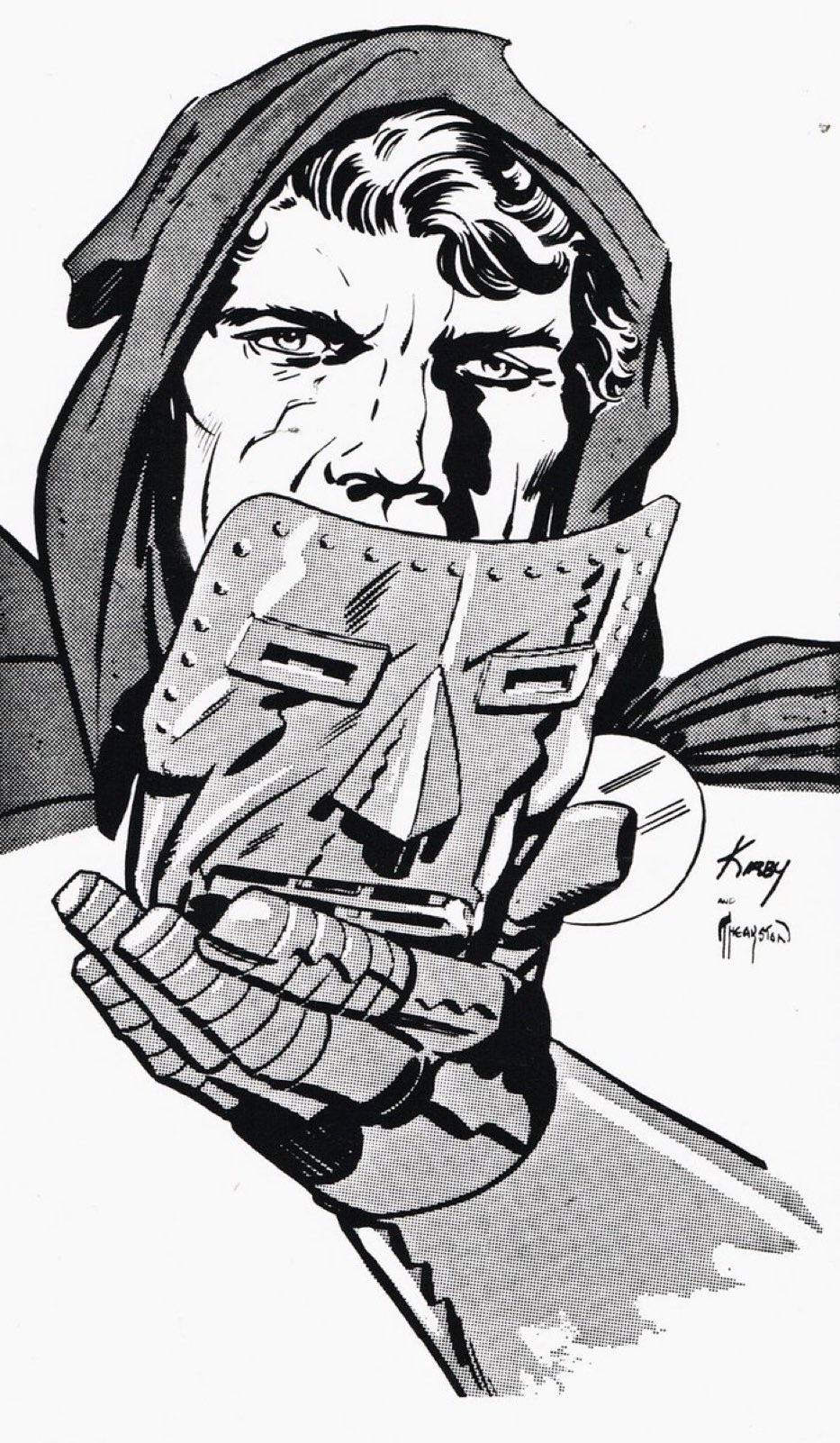
…he’s a good-looking guy, and he only has a tiny scar on his cheek, but because he’s such a perfectionist, he can’t bear to see that imperfection. He isn’t hiding his face from the public, he’s hiding it from himself.
Jack Kirby, Artist and co-creator of Doctor Doom
Kirby claims this was his original intent. However, I doubt medical professional Donald Blake would react so strongly to a minor scar.
Certain Doctor Doom toys would feature removable masks for Doom. On some toys he had an entirely scarred face, and on others he had only a small scar.
Writer/Artist John Byrne found a way to merge Kirby’s vision with Marvel canon in 1985’s “The Fantastic Four” #278.
Doom is presumed dead, so his doombots implant a copy of Doom’s mind into his apprentice, Kristoff. The comic follows Kristoff reliving Doom’s life, through these implanted memories.
In this issue Doom’s face is shown after his accident for the first time.
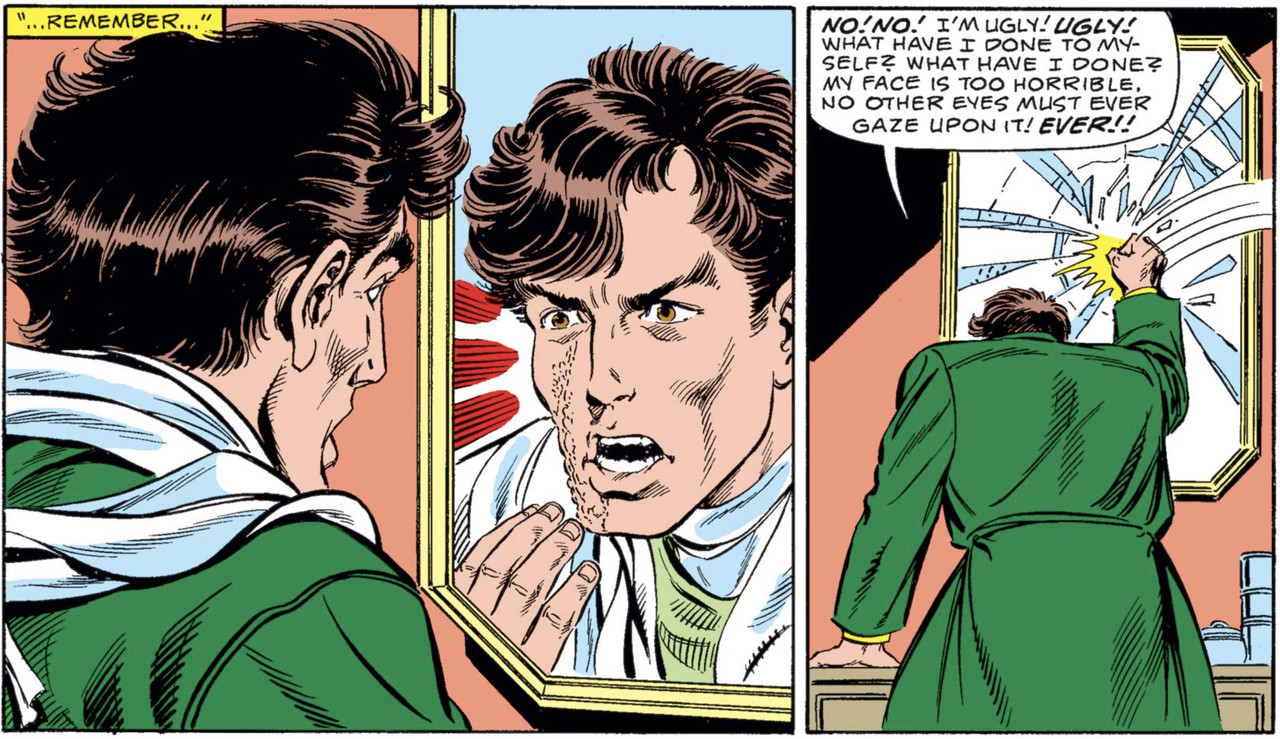
Doom is devastated by a cheek scar, just like Kirby imagined. But what about Dr. Blake’s reaction? Shouldn’t Doom be horribly scarred if medical science has no hope of restoring his appearance.
Byrne solves this in the scene where Doom first dons his iconic armor.
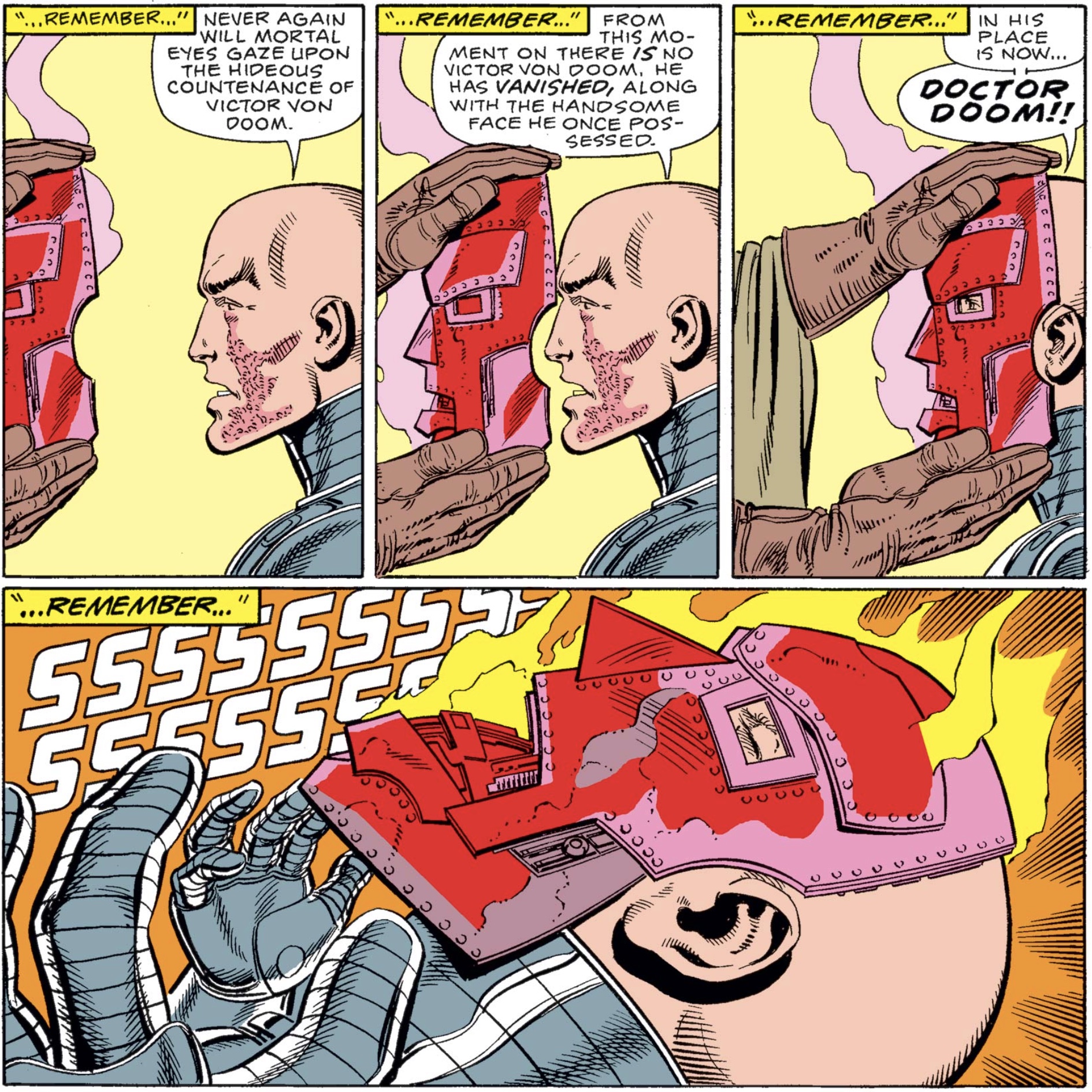
Doom, incapable of tolerating mere seconds of his face being exposed, instructs the monks who made his armor to apply the still scalding mask to his face immediately.
This fits with Stan Lee and Jack Kirby’s original telling of Doom’s origin, which showed Doom applying his mask before it had fully cooled, although the monks applying the mask do so with bare hands.
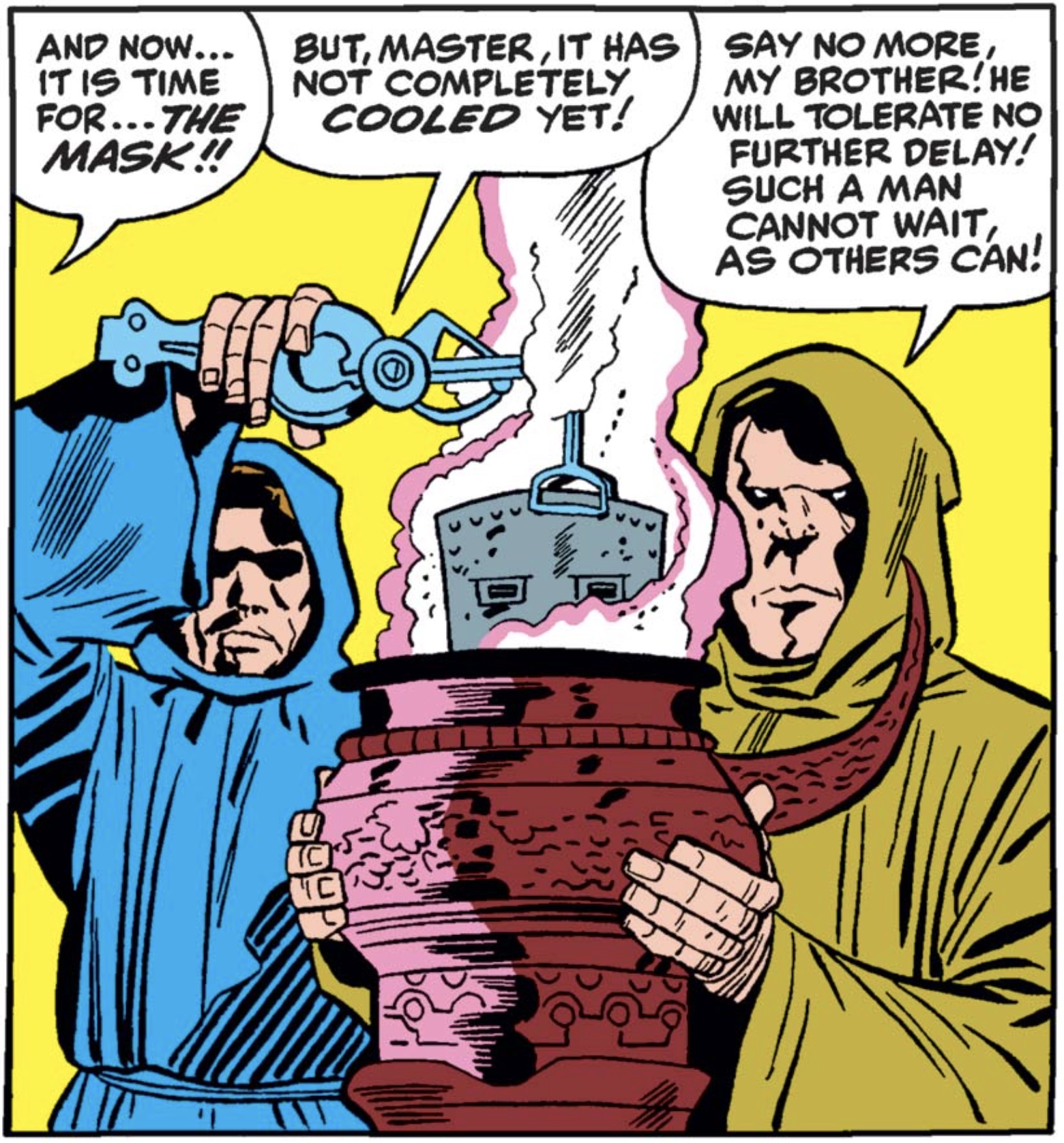
(I know the monk isn’t touching the mask here, but he handles it with bare hands in like the next panel, trust me.)
Still, Doom’s face behind the mask would remain a mystery, but if his face had been destroyed, it would have been an escalation of a previously minor injury. One flaw was enough for Doom to decide that his whole face was beyond saving. Doom’s encasement in armor serves a metaphorical purpose as well. Doom has literally built a protective barrier between himself and the world.

Doom would gain the godlike power of The Beyonder in 1985’s “Secret Wars” #10, and reveal he had healed his face in the following issue.
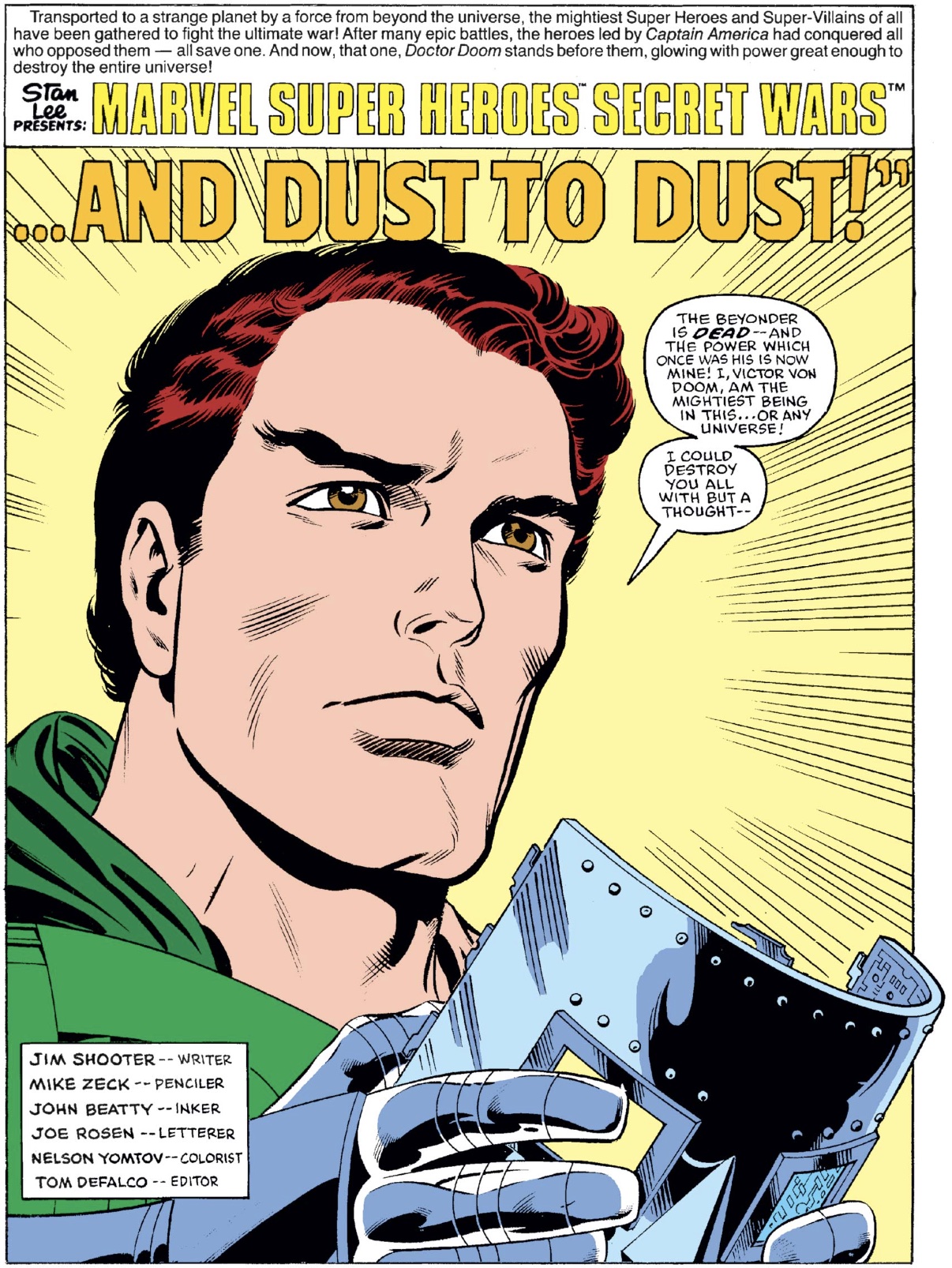
Then, using the stolen powers of Scarlet Witch, Doom would heal his face once more.
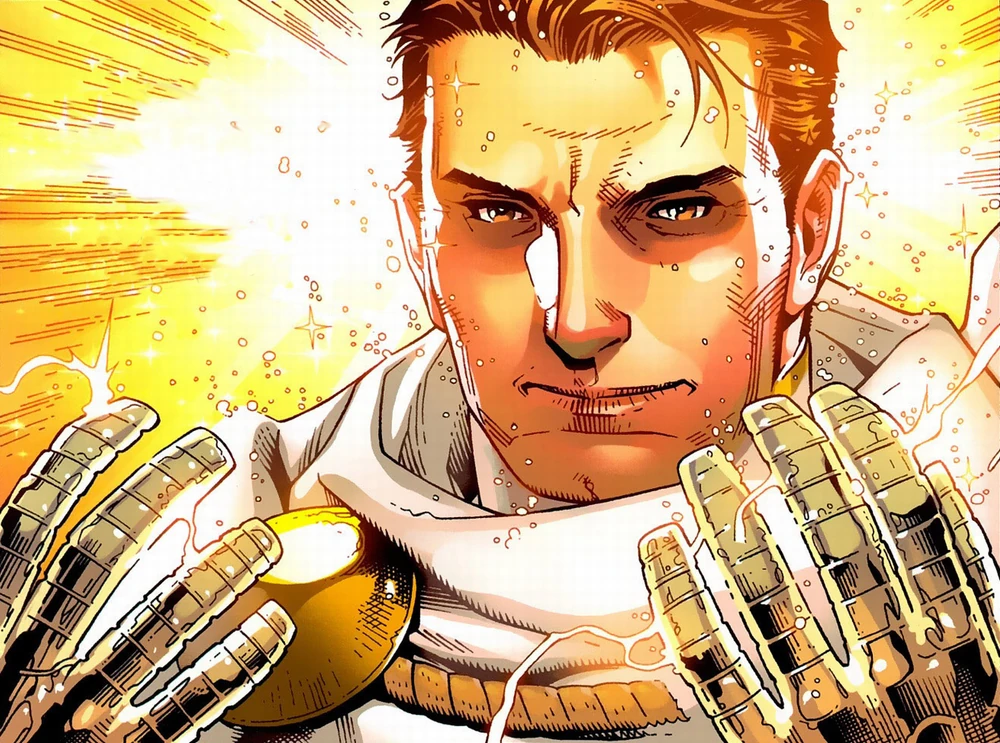
In both stories, Doom loses his godlike power and his face returns to normal.
Here’s The Thing
From Mayo Clinic.
Signs and symptoms of body dysmorphic disorder include:
- Being extremely preoccupied with a perceived flaw in appearance that to others can’t be seen or appears minor
- Strong belief that you have a defect in your appearance that makes you ugly or deformed
- Belief that others take special notice of your appearance in a negative way or mock you
- Engaging in behaviors aimed at fixing or hiding the perceived flaw that are difficult to resist or control, such as frequently checking the mirror, grooming or skin picking
- Attempting to hide perceived flaws with styling, makeup or clothes
- Constantly comparing your appearance with others
- Frequently seeking reassurance about your appearance from others
- Having perfectionist tendencies
- Seeking cosmetic procedures with little satisfaction
- Avoiding social situations
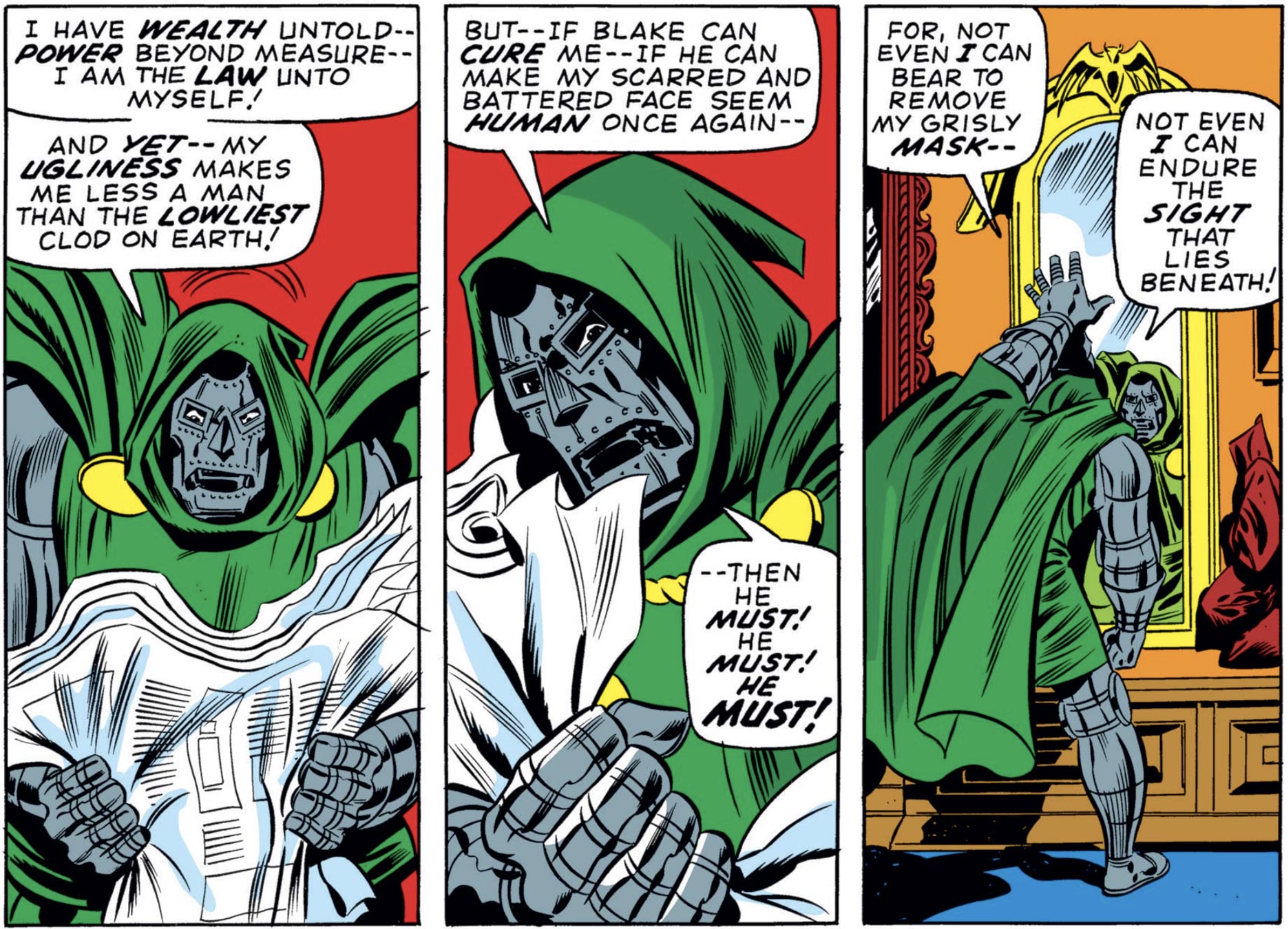
Doom checks every single box for body dysmorphic disorder. So does The Thing.
By no means do I mean to make the case that either character should be representative of the disorder, but it’s difficult not to see the similarities. Maybe you think that cheap disposable entertainment from the 60s wasn’t meant to be taken so seriously, but then why are you even reading this?
The Thing, in his earliest appearances, is a man mourning his old body. His unbreakable, rock-like hide can be compared to Doom’s scarring and his armor. When we first see The Thing in “Fantastic Four” #1 he wears a trench coat.

But when we’re introduced to him in full, his costume is nothing more than a pair of shorts, flaunting his condition to the world, and even expressing relief to have removed his outerwear. Contrast this with Doom’s refusal to remove his armor.
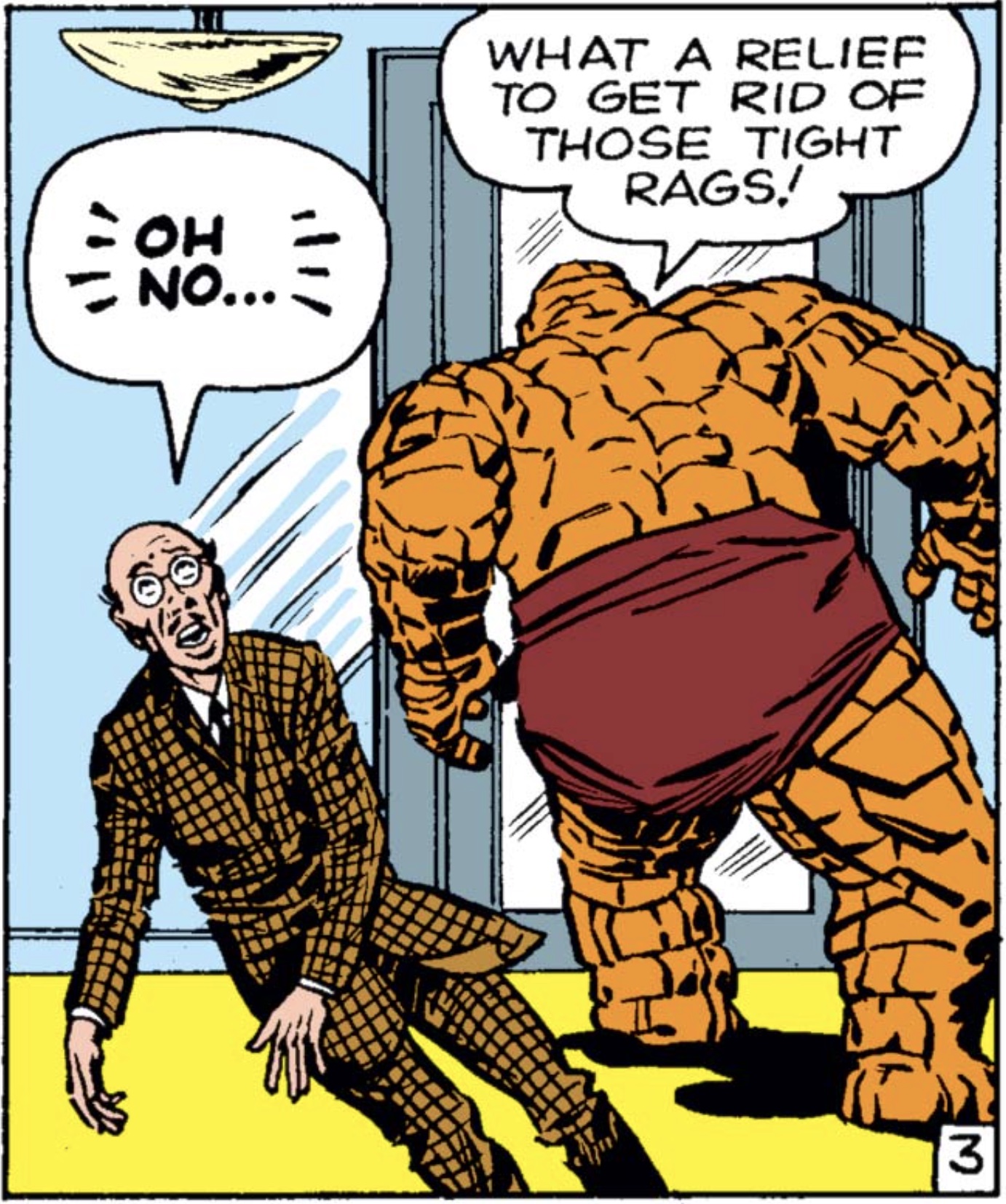
Deep down, even in recent comics, we can see that The Thing, despite his celebrity, is still quite sensitive about his appearance.
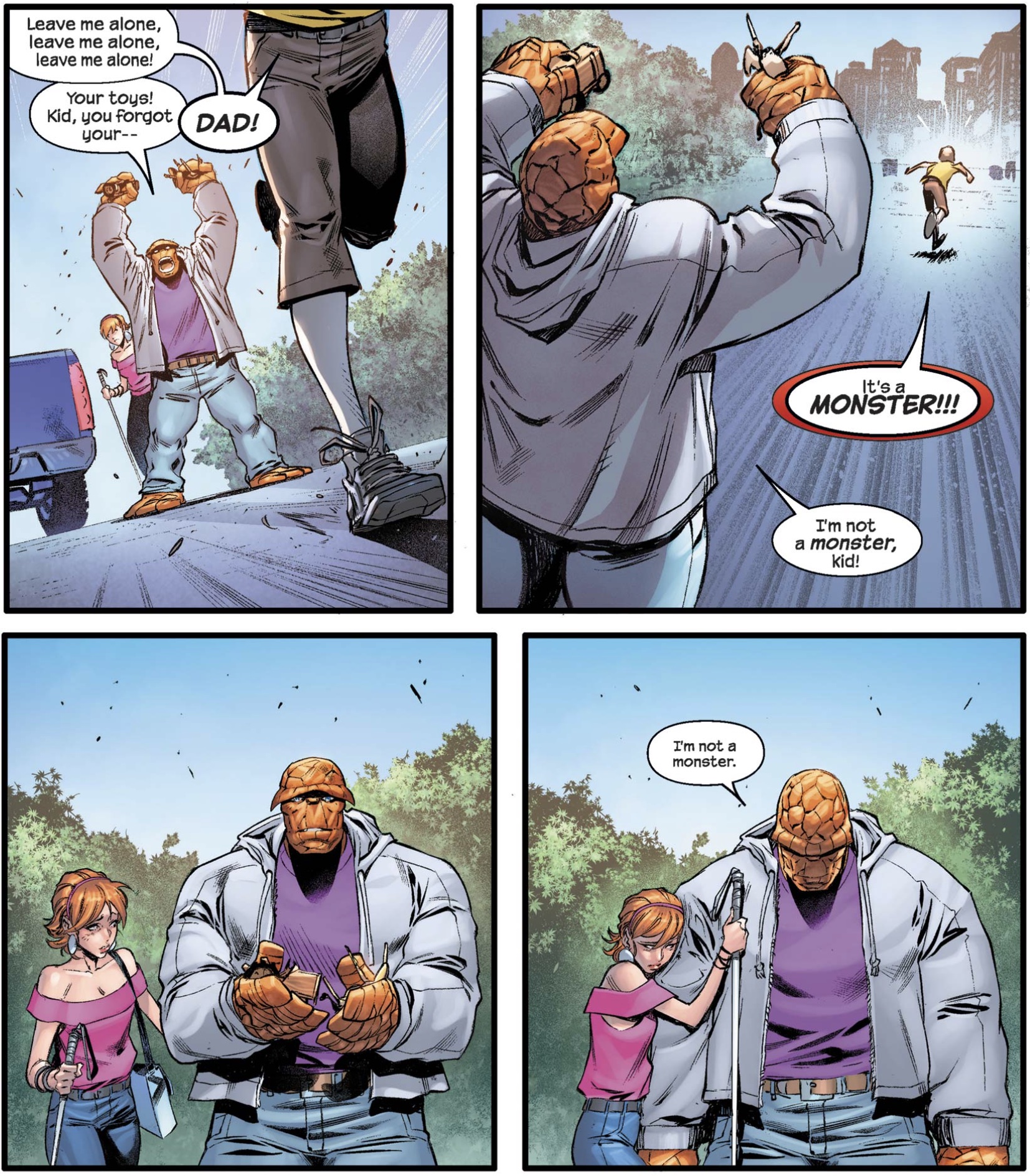
On the Fantastic Four’s ill-fated space flight that gave them their powers, Ben Grimm was the sole dissenting voice. He alone argued that the quartet was not ready to go to space (on an unauthorized mission, mind you). He correctly predicted there could be unforeseen consequences.

Just like Doom, (remember, Reed interfered with Doom’s machine,) The Thing has reason to blame Reed Richards for his disfigurement.
But Ben Grimm did not isolate himself. He, unlike Doom, forgave Reed for causing his disfigurement and learned to accept his new appearance, even sharing it with the world, regardless of if he likes it or not. Doom continues to hide his face, and blames his scars (and by extension, Reed Richards) for his separation from the rest of the world.
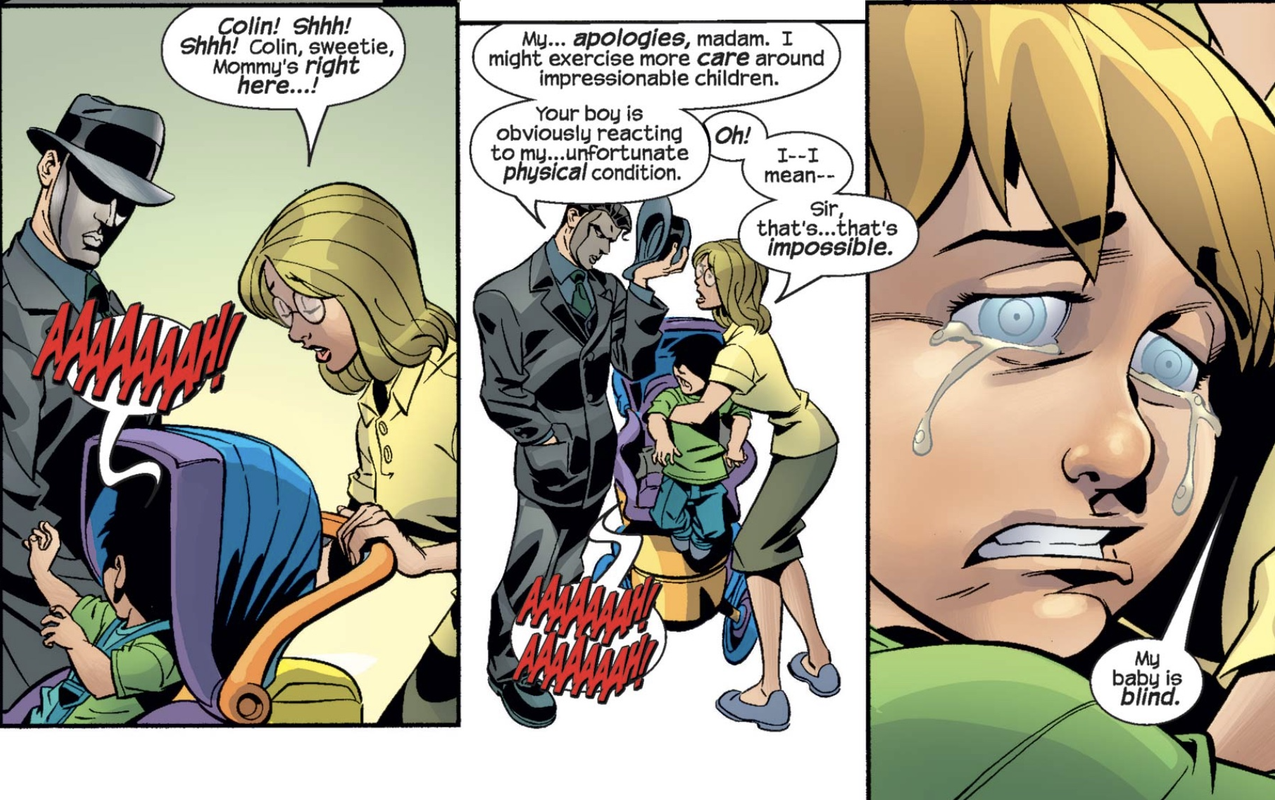
Ant-Man Makes Doom Feel Small
Doctor Doom (accidentally) killed Cassie Lang, member of the Young Avengers, and daughter of Scott Lang, aka Ant-Man.
After a long story where Doom, once again, obtains godlike power. (He merged with Kang the Conqueror, and Annihilus to become “Doom the Annihilating Conqueror.”) Ant Man finally confronts “Doom the Annihilating Conqueror” and, with his team of fill-in Fantastic Four members, neutralizes Doom’s new abilities.
Ant-Man then forcefully removes Doom’s armor, including his mask.
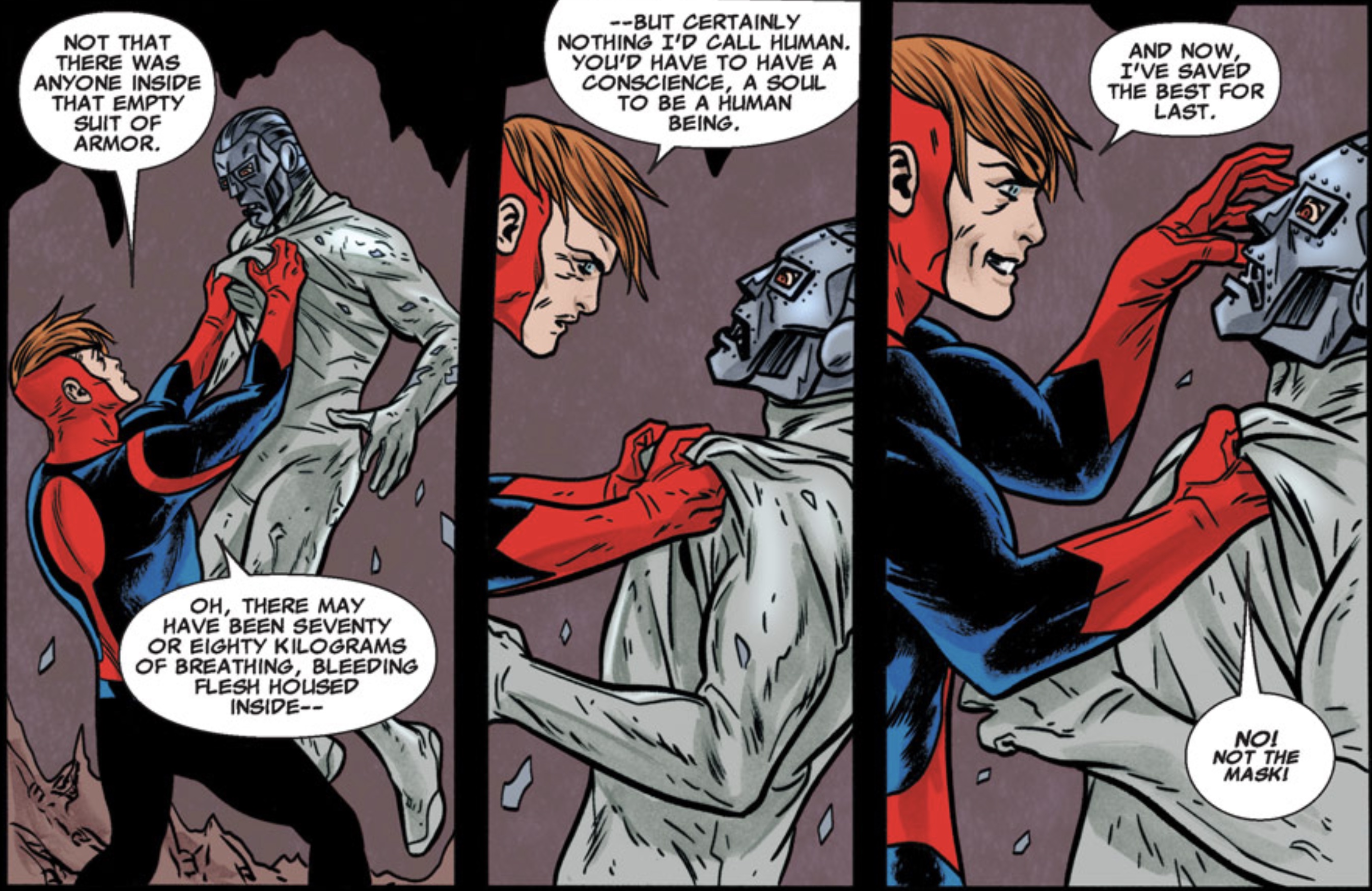
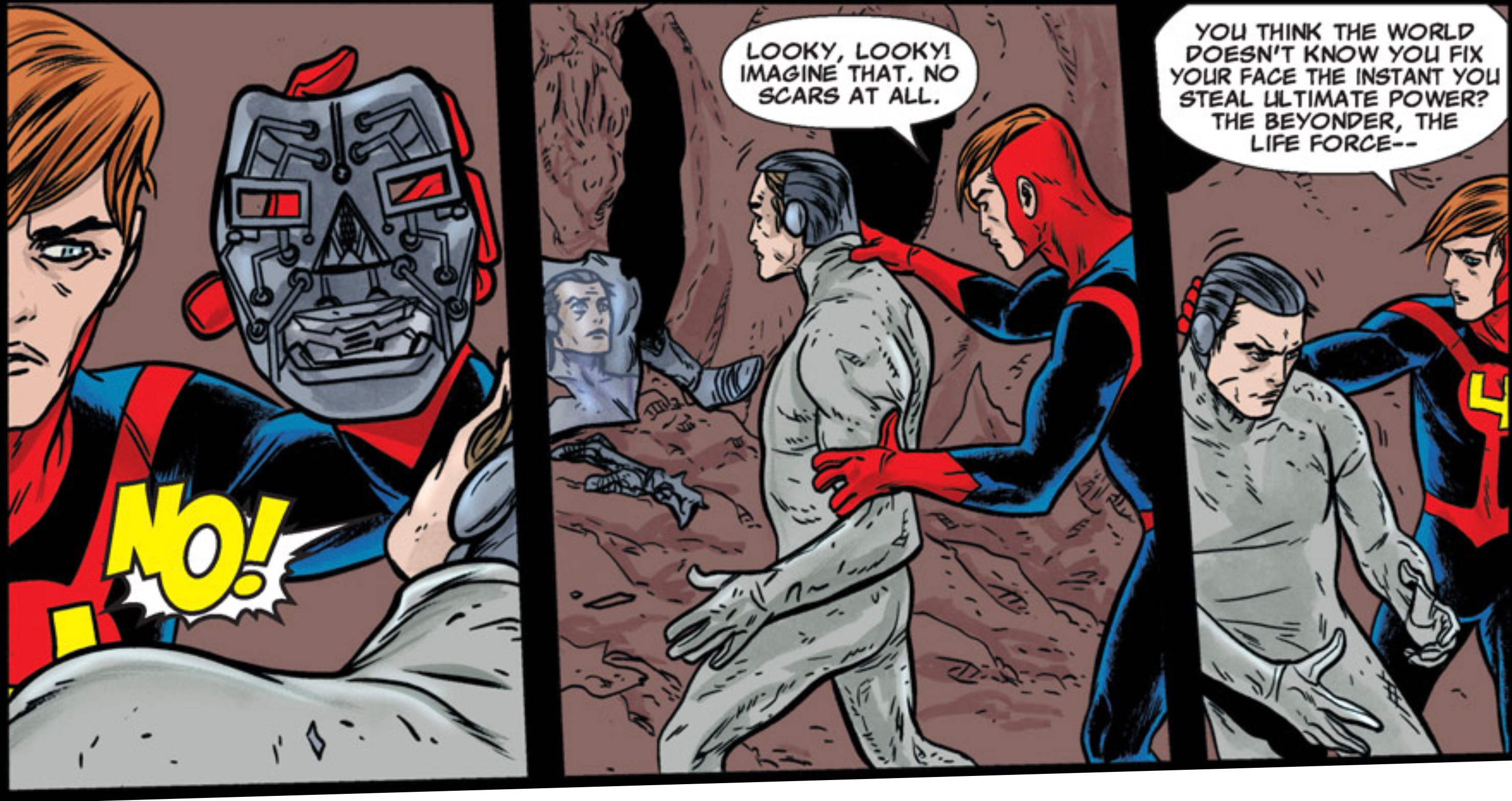
Predictably, Doom has healed his face with his power. (Again!)
Doom is confronted by The Living Tribunal. (The Living Tribunal is a sort of cosmic judge, who hands out judgements on great cosmic crimes. Not to be confused with Arishem the Judge, who judges which civilizations are allowed to live or die. Not to be confused with the Time Variance Authority, who enforce and punish time law. Keep up.) Due to his hubris with his godhood, he is cursed to have his face scarred with each act of Malice he commits.
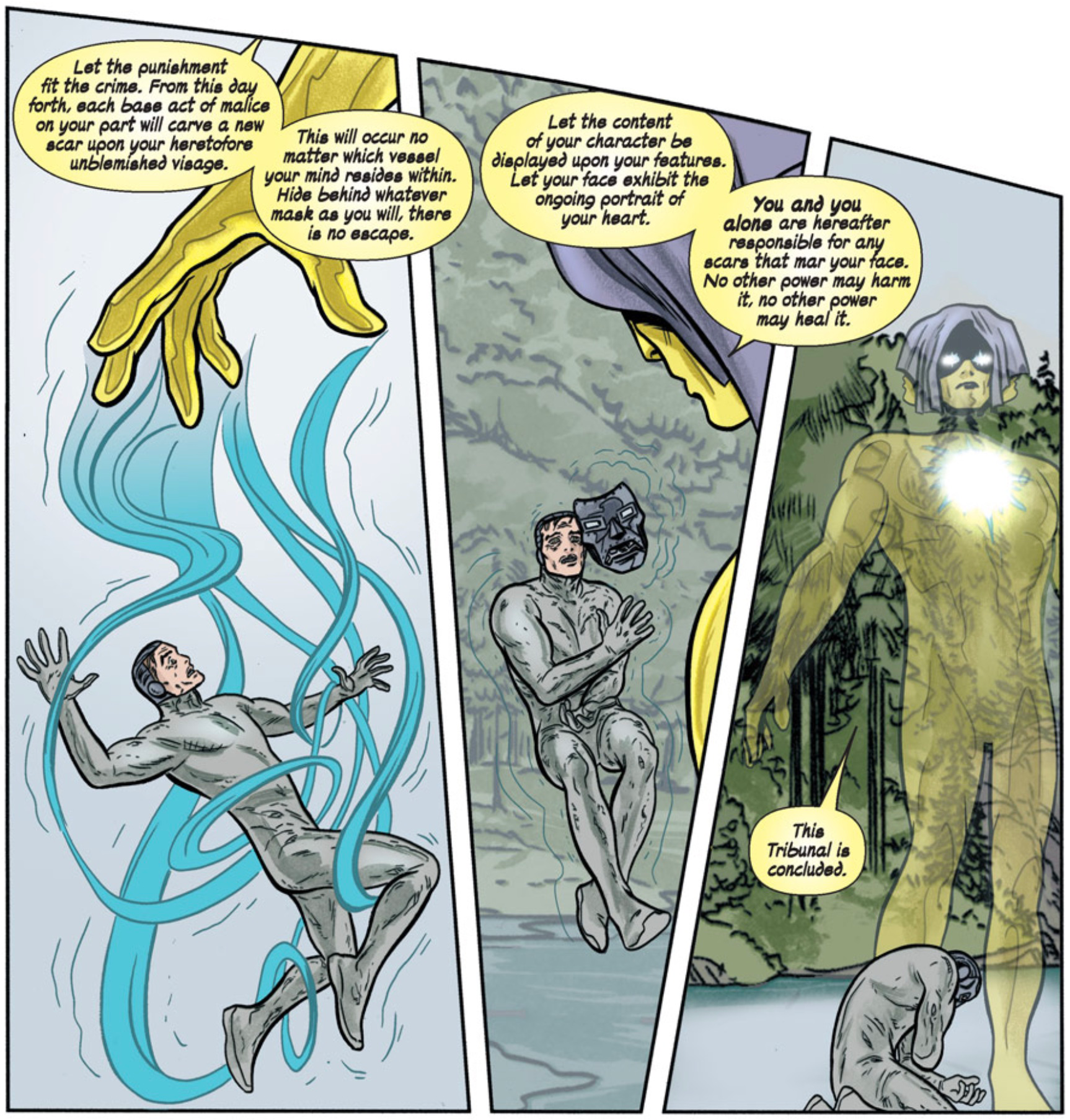
While Lang was initially set on murdering Doom, he decides he would rather beat doom within an inch of his life.

Secret Wars
In “Secret Wars” (the second “Secret Wars,” from 2015, not to be confused with “Secret Wars” from 1984, or “Secret Wars II,” which is something else entirely) Doom becomes “God Emperor Doom” and reshapes the universe to his liking, using godlike abilities, stolen from the Beyonders, who were destroying the multiverse. (The Beyonders are a race of gods who created the multiverse, not to be confused with “The One Above All,” who is also god… somehow.) Doom stood alone against the Beyonders and was the only human capable of stopping their premature destruction of everything.
Doom’s new world was an amalgamation of every piece of the multiverse he could possibly save, although, with his abilities, it’s impossible to know which parts of the world he created, and which parts he saved.
This is hardly Doom’s first time being god. But this time Doom seems less sure of himself.

And yet, despite the reassurance of his wife (yes, Doom, when given godlike powers, chooses Sue Storm for his bride. Does this mean he loves her, fueling his hatred for Reed further? Or does he simply covet what Reed has?)
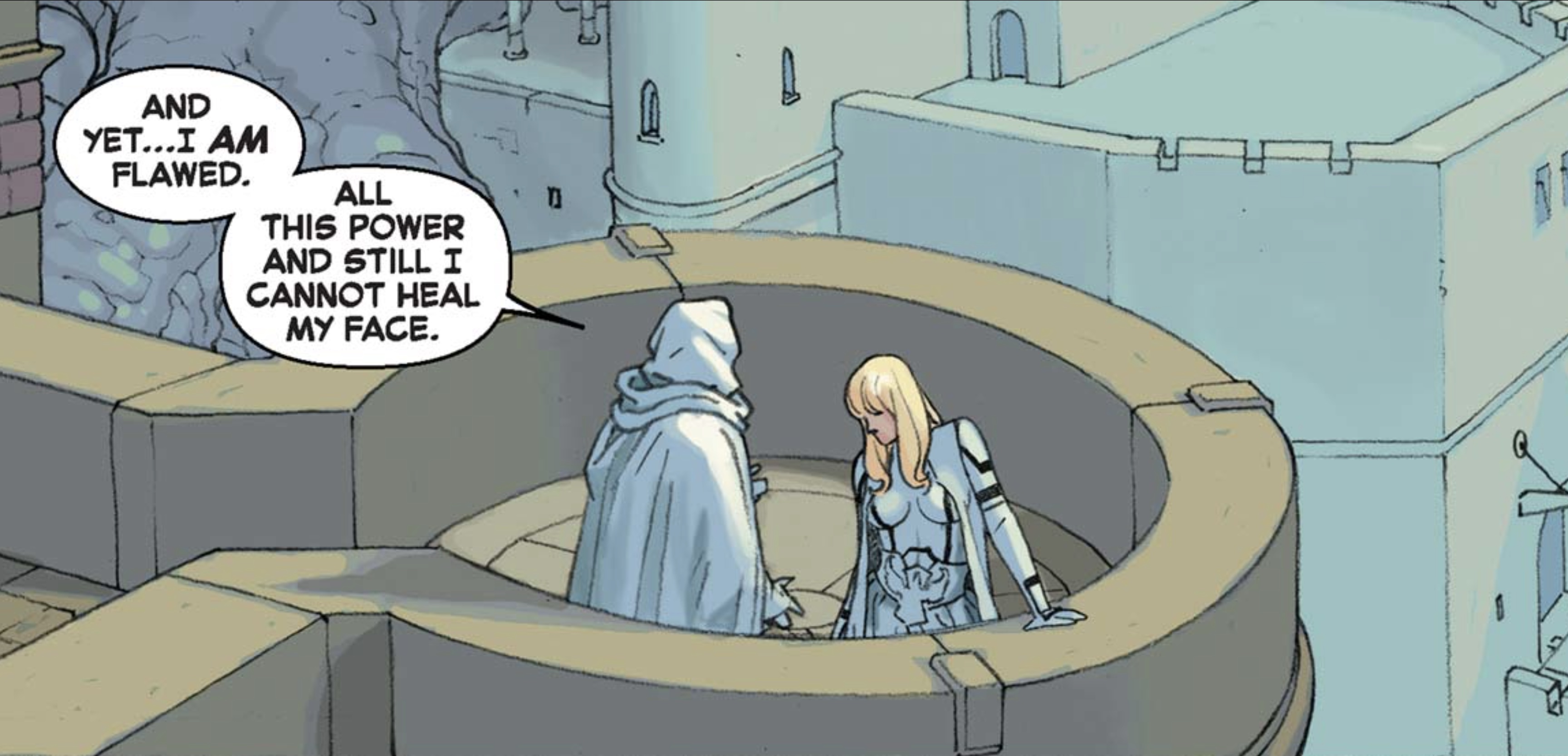
Finally, after 53 years, Doom’s face is revealed.
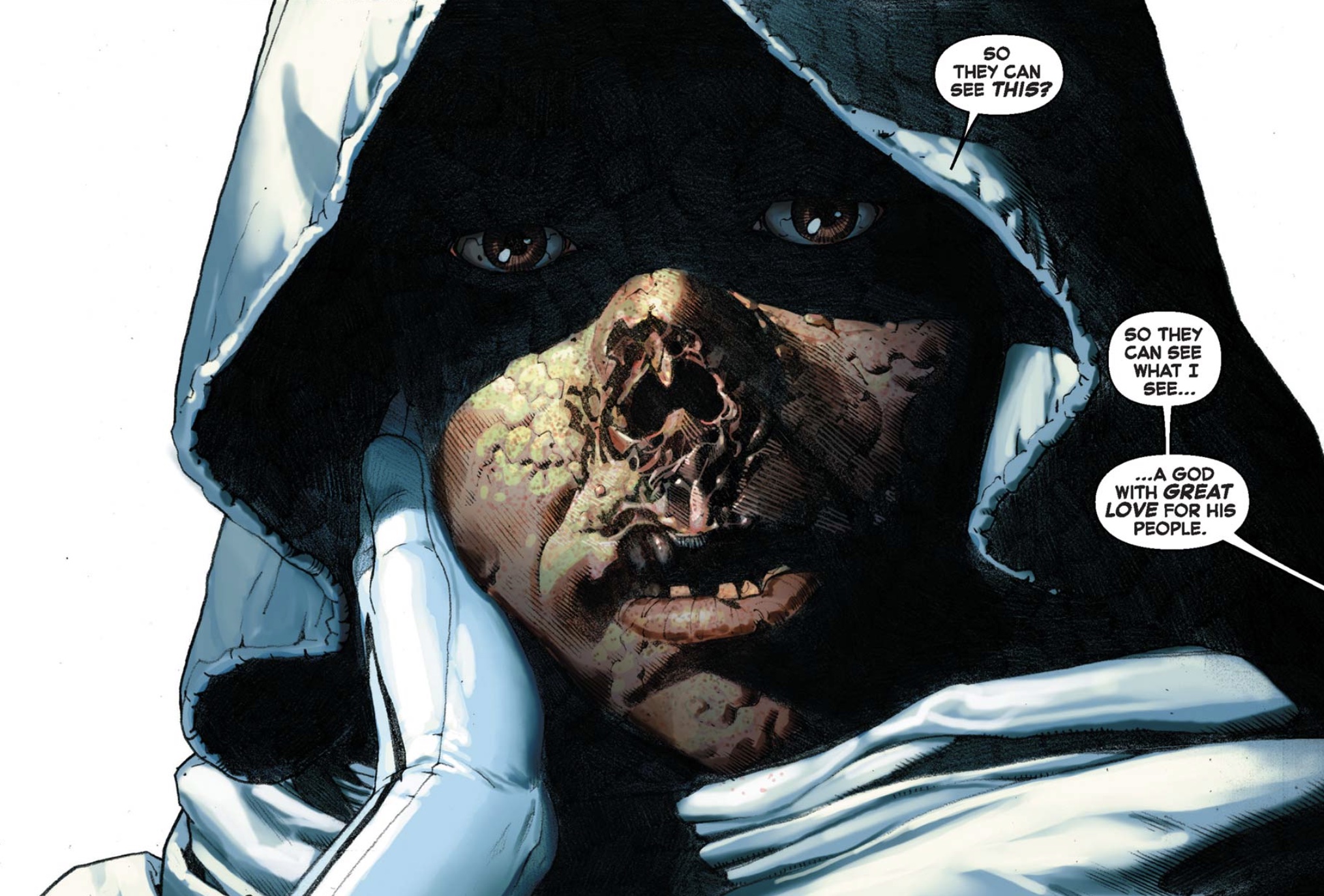
Yucky!
Donald Blake… I get it.
Why doesn’t he fix his face? He’s done it before.
We can only speculate on what actually caused this inability for Doom, but I suspect it has to do with the fact that he can no longer deny his internal ugliness. The key difference between this story and other God-Doom stories is that, here, Doom has designed the world from the ground up, exerting a level of control never before seen. He has also spent eight uncontested years as god at this point. Now that he can find no flaws in the exterior, the source of his distress must be internal. Doom can’t bring himself to perfect his face because now, he sees it as a reflection of his internal distress.
“I’m beginning to think that in my perfect world… I am the one flawed thing.
Doctor Doom, in the panel literally three images up. You’re supposed to be reading those things, man. I had to screenshot them. That takes time.
Or maybe (this is a big maybe), his theft of godlike power was an act so cruel, that his face became that scarred. Remember that Doom was cursed to be scarred with each act of malice only one year before this story. This curse is never really acknowledged again however, so in all likelihood it just became a overwritten piece of Marvel canon, immediately forgotten by the next writer. (There’s a lot of those.)
It’s worth noting that Doom’s scarring was always self-inflicted because he couldn’t accept one small imperfection on his face. He abandoned the good because he desired the perfect. It’s quite possible that Doom did redesign his face with his power, but perhaps worsened his scarring to reflect his growing self-doubt. Or, he reformed his face into what he thinks it looked like, which may be worse than the reality. Different parts of our brain activate when we recognize our own face.
In fact, although the areas typically active during perception of both self and other familiar faces are adjacent and partially overlapping, it is possible to experimentally disambiguate between them. Further, some studies found a right hemisphere dominance for self-face perception compared to others’ face perception [even though other studies found equivalent bilateral activations for both self and others discrimination, probably reflecting differences in task context; see Platek et al. (2006) for a discussion of the latter point].
Face yourself: The social neuroscience of mirror gazing
That’s right. Science.
In a final battle, Doom admits that Reed is better than him, although he did so while attempting to murder him. This final admission causes Doom’s godhood to move to Reed, who now remakes the world into the Marvel universe we have today.
This is what always causes your fall, Reed. Abandoning the good because you desire the perfect.
Doctor Doom
As a final gift to Doom, Reed leaves Doom’s face unscarred in the new world. Doom would briefly spend some time as a new Iron Man before eventually regaining his scars during battle with “The Hood” and returning to his villainous ways.
Childhood
Doom spent his early life in a Romani camp in the fictional, Eastern European, country of Latveria. The baron of Latveria was an oppressive ruler who mistreated Doom and his family.
Mother’s loving arms. How I lived for her embrace, as all boys do. If only I could have known why her hands were always so cold.
Doctor Doom
(technically, it was a doombot programmed with Doom’s memories but it’s basically Doom.(if you want me to somehow explain every convoluted plotpoint, this post would be triple the size. That’s right, I don’t want that either.)
Doom’s mother made a deal with the demon Mephisto and engaged in black magic to achieve revenge on the baron and his men. She ventures into the village and begins her assault on the Baron’s men. Because Mephisto is the literal Christian devil within Marvel continuity, there was, expectedly, a tragic twist. The magic also killed the village children and Doom’s mother was killed by a dying guard. Her soul was forfeit to Mephisto due to their arrangement and she was banished to Hell, inspiring Doom’s future research into both science and magic.
Doom first met Valeria (his girlfriend in the first story. Remember? The one who’s skin Doom made into mystical armor. Keep up.) when they were children in Latveria. The two seemed to share a genuine romance for many years, her relationship was one of the few that Doom seemed to value.
Doom’s father, after failing to heal a noble, was murdered by the Baron’s men.
Doom was recruited by the military as a young man to study in America, where he happened to study in the same university as Reed Richards and Ben Grimm.
This childhood of trauma would seem to explain Doom’s isolation. He lost his entire family and was revered for his intellect by a foreign superpower. But, Ben Grimm grew up poor in New York, lost his brother to gang violence, lost both parents before he entered high school, and suffered an (arguably) even worse disfigurement.
Perhaps this would suggest that Doom’s mania, ego, and vanity, are a result of weakness and choice. Maybe Doom is weaponizing tragedy to excuse his evil nature. If this were the case, Doom would shift from a tragic figure into one of evil. Importantly however, in almost all iterations, Doom is obsessive. Doom is not capable of what Ben Grimm could do, Doom can’t accept change that he doesn’t create.
Dictator Doom
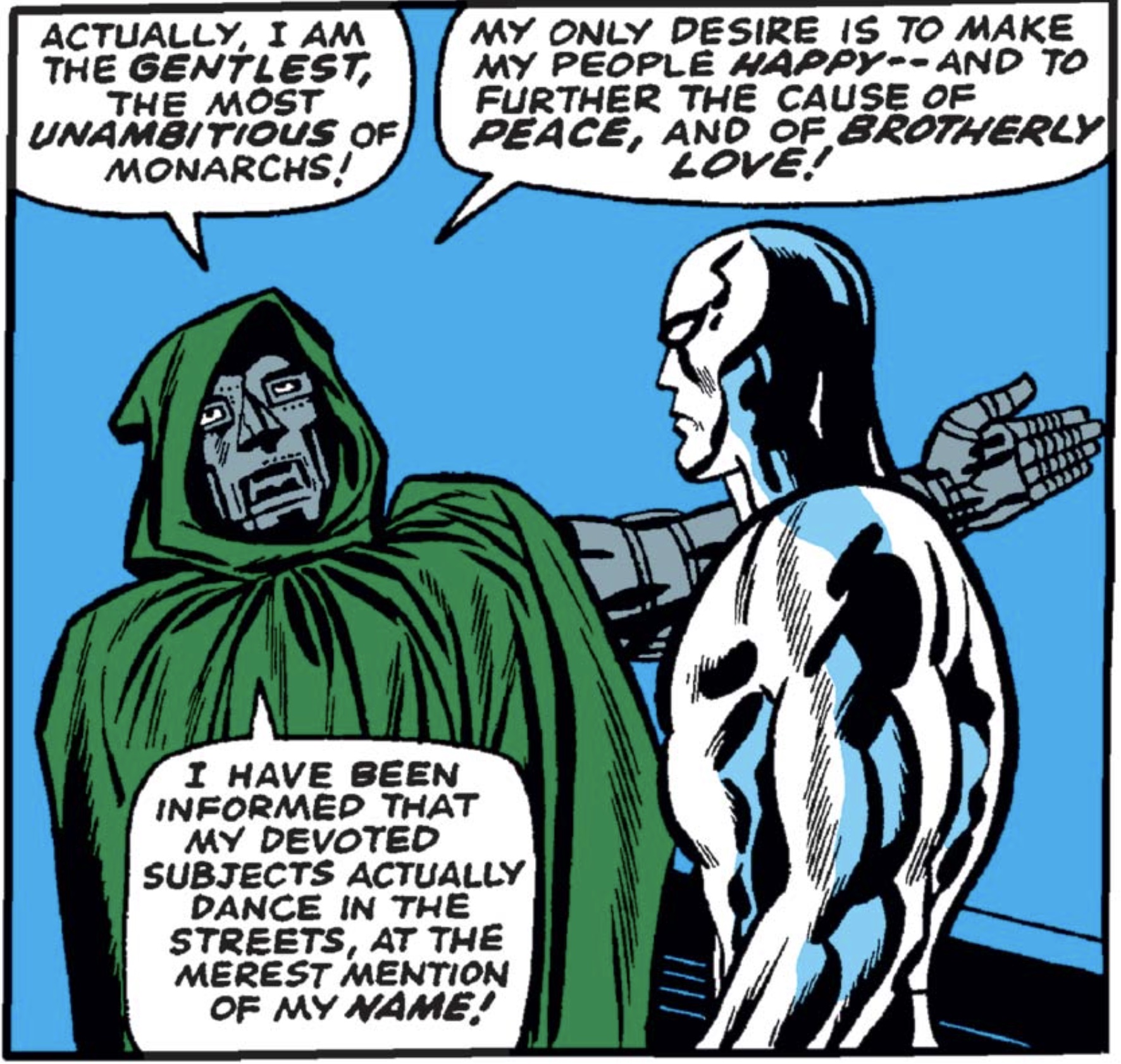
Stan Lee and Jack Kirby, Doom’s creators, were both Jewish men who served in World War II. Their creation of Doom also happened in the context of the Cold War. Dictators and Fascism were all around. Is Doom supposed to be Stalin or Hitler? Probably neither. Doom is an embodiment of the evil world leaders of the time, not representative of a specific person.
As time went on, this idea would become less relevant, as the Soviet Union dissolved and America became the sole world superpower.
Doom would shift from despotic leader, to benevolent master between writers, but Latveria, his country, would always be doing well economically and socially. The overall happiness of the people is extremely inconsistent between runs. Sometimes, Doom attacks his own people with killer robots, just to test them out. Other times, he’s absolutely adored by his loving subjects.
Doom would evolve with the times. When Doom was trapped in Hell during Mark Waid’s Fantastic Four run, his people missed him. It was shown that Doom’s people had everything they could desire in an almost utopian society. Doom has always been a respected, and even beloved monarch.
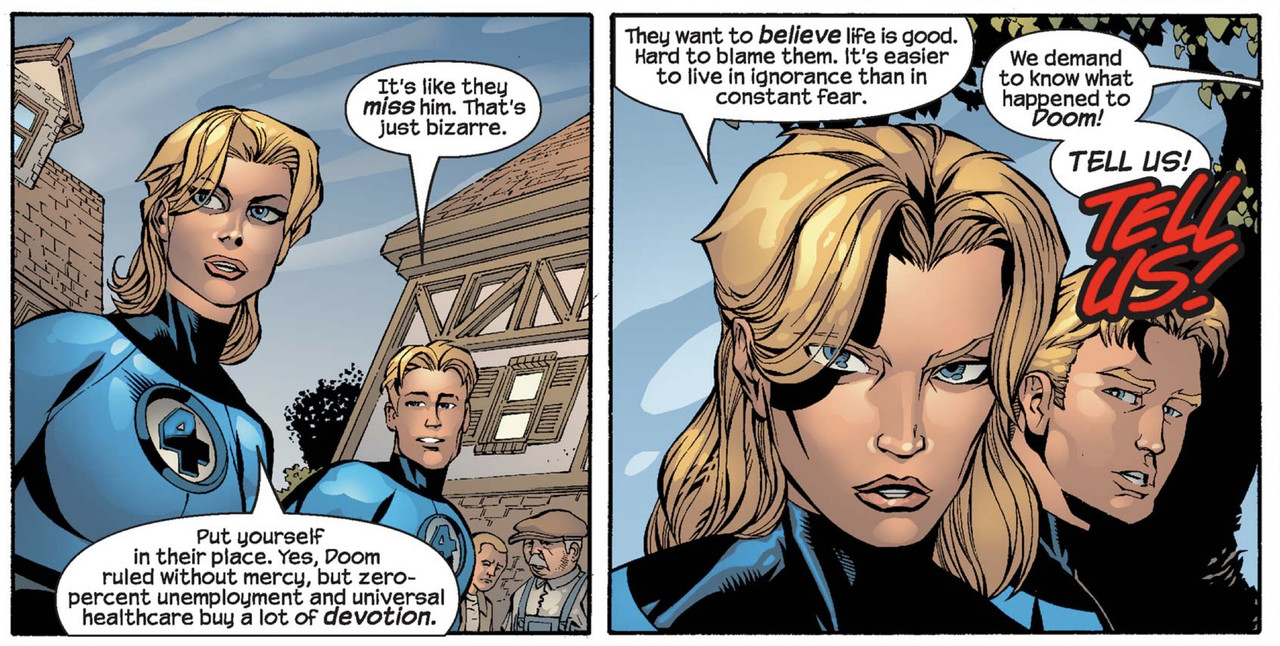
Yes, in order to form this paradise, Doom required complete control, but if he’s such a good ruler, does he deserve it? Doom’s goal (outside of murdering Reed Richards) is to conquer the world, or perhaps even the universe. If he means to bring about world peace, and he would likely succeed if given the chance, would he be the hero of the story?

Emperor Doom
After imprisoning the purple man, who, using pheromones, can force anyone nearby to follow his verbal commands, Doom is able to utilize the purple man’s power for himself and apply the effect to the whole world. In other words, Doom can command everyone to do whatever he wants.
Doom himself seems to be the only human capable of resisting the purple man’s pheromones, due to his extraordinary willpower.
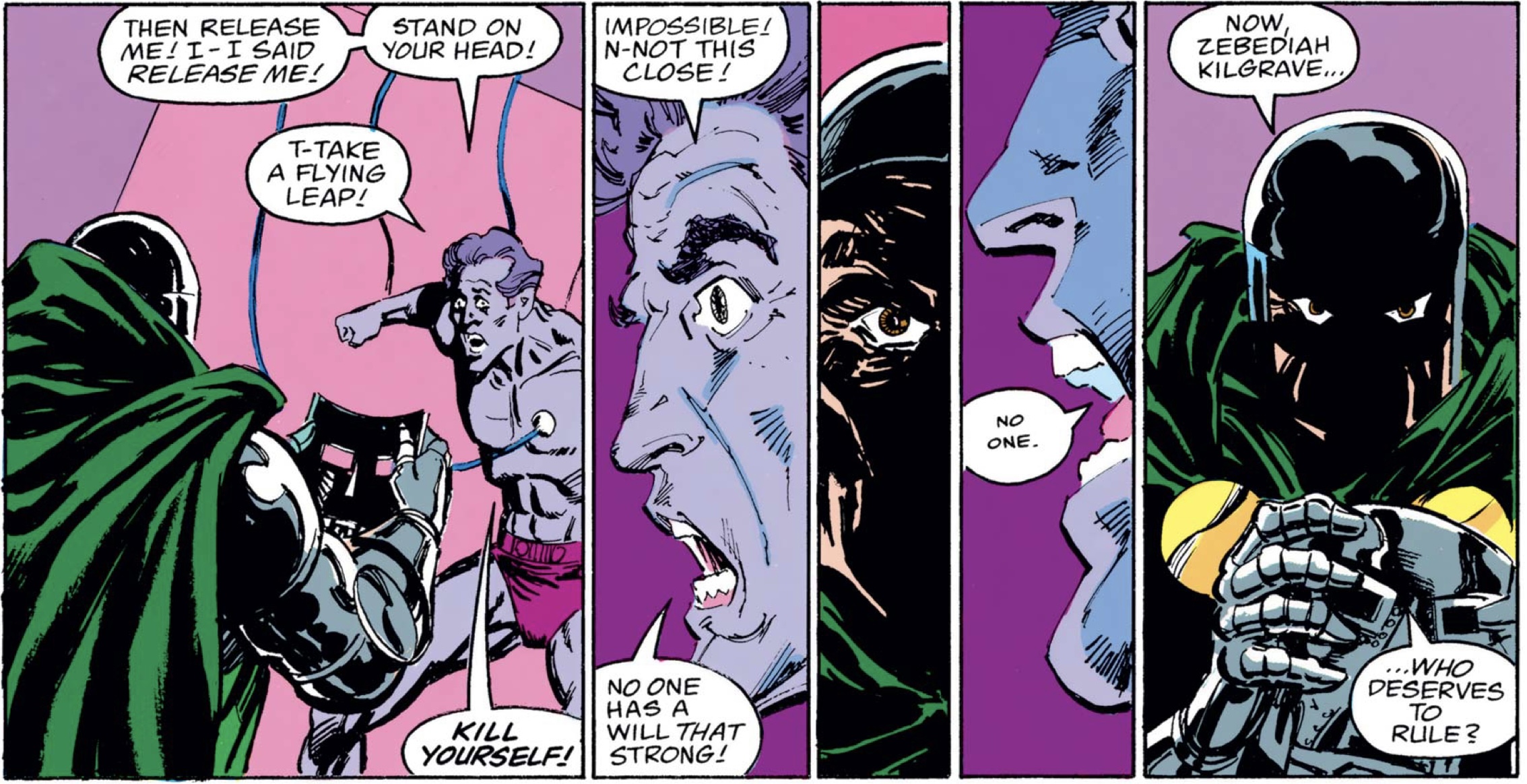
After successfully conquering the world, Doom is confronted by the Avengers who have managed to break free from Doom’s mind-control. Doom, like Megamind (but decades before “Megamind” was released), has found his victory over the world to be hollow, and decides not to deploy nerve gas to stop the Avengers.
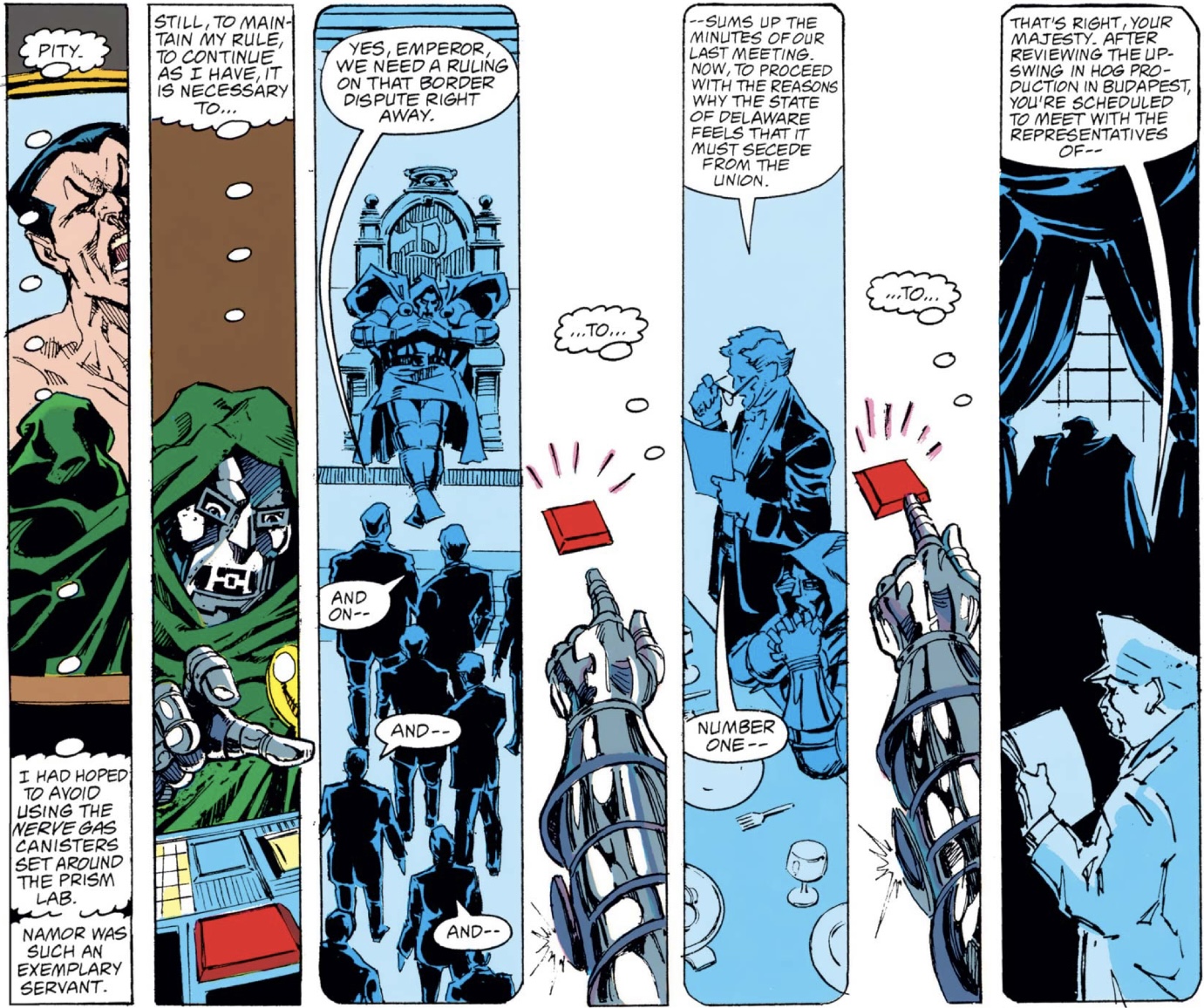
At the end of the story, even the Avengers wonder if stopping Doom’s rule was the right thing to do. Doom had ended crime, poverty, and even apartheid (this was in 1987). The world, under Doom’s rule, was a better place, depending on how you look at it. Sure, people were incapable of disobeying Doom, but ask the people in South Africa suffering under apartheid what they prefer.
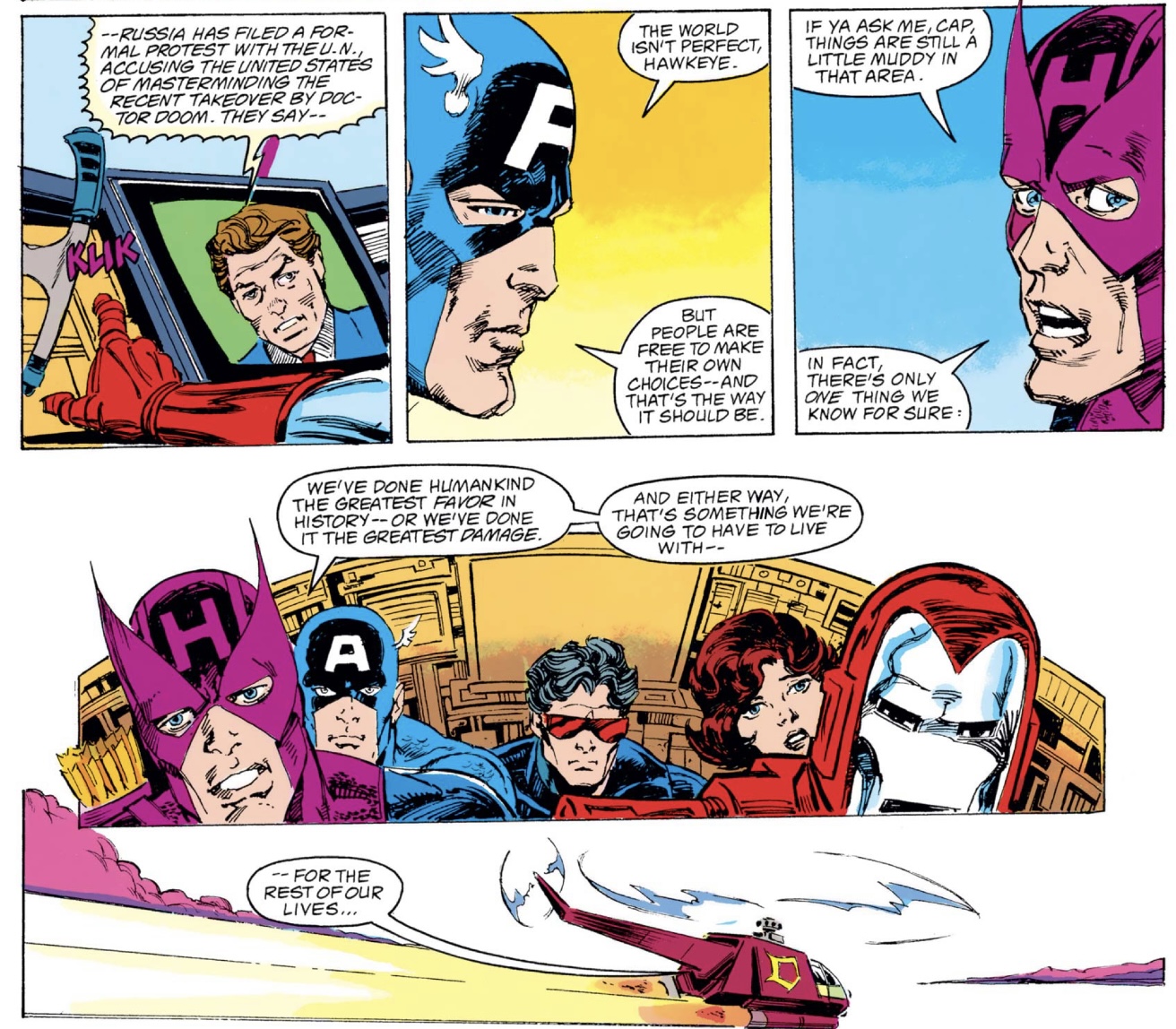
Doom relinquishing control is a moment I’m not sure is completely in character. I believe that Doom, if unsatisfied with his rule over the world, would more likely set his sights on conquering the universe. Even if Doom conquers all, he won’t be satisfied, but you can’t convince him of that until after he’s proven it to himself.
What If?
“What If?” was a series that had The Watcher (a member of a race of omniscient aliens who are pledged to record all of reality but never interfere) narrate an alternate history of the Marvel universe, with some event being changed, including: “What if Gwen Stacy had Lived?” and “What if Captain America had Become President?”
“What if Doctor Doom had Become a Hero?” was the title of 1980’s “What If?” #22
The fateful moment that alters Doom’s trajectory is…

When Doom decides to double check his calculations, accepting Reed’s corrections, his experiment is a success. Doom frees his people from the oppressive baron and fashions a golden armor for himself. He even marries Valeria. (Skin armor girl.)
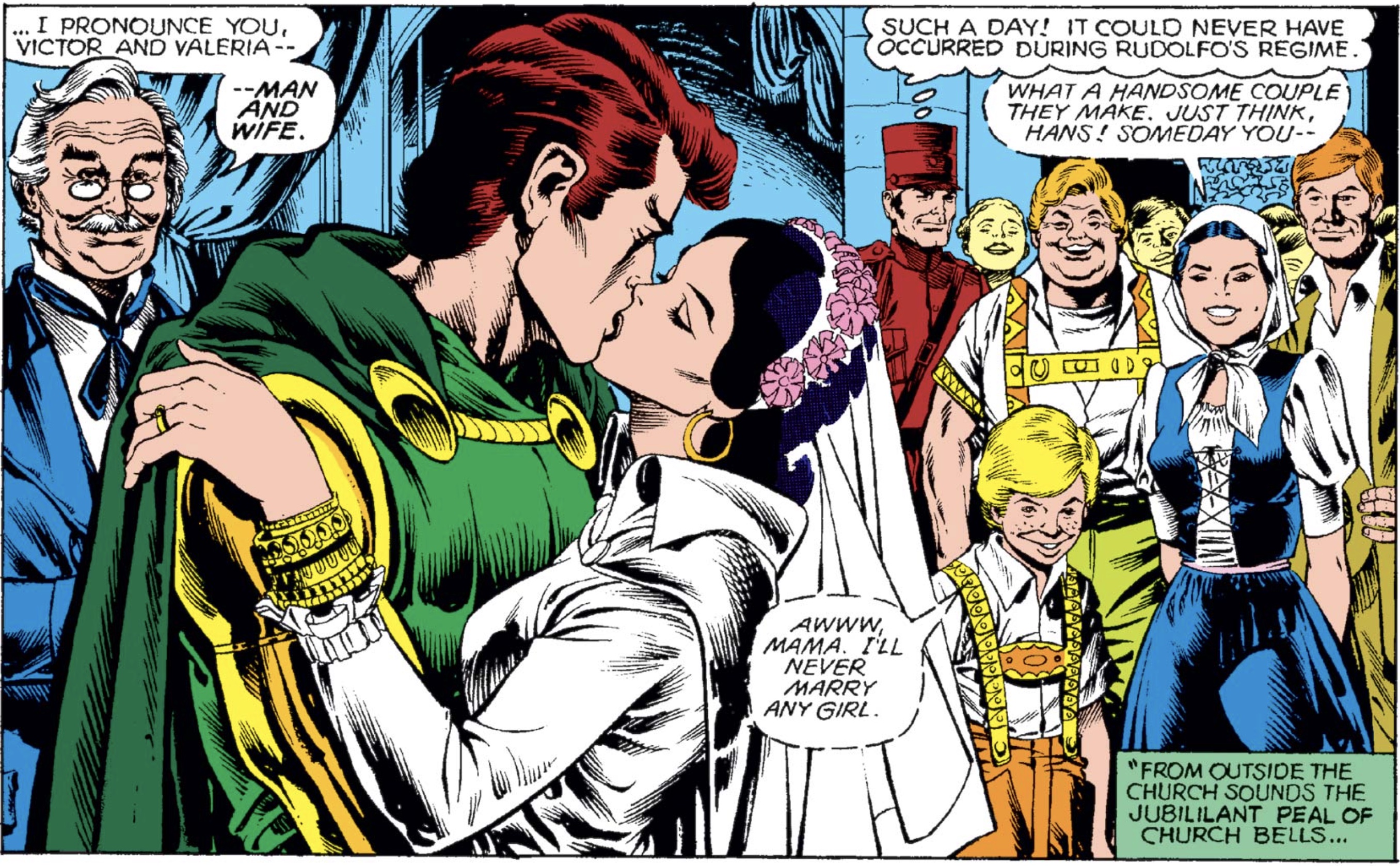
He goes on to free his mother from Mephisto, but Mephisto takes notice. Mephisto decides he must punish Doom, so he offers Doom a new deal, to replace the soul of Doom’s mother, Doom can offer his own soul, or Mephisto will claim the soul of his wife, Valeria.
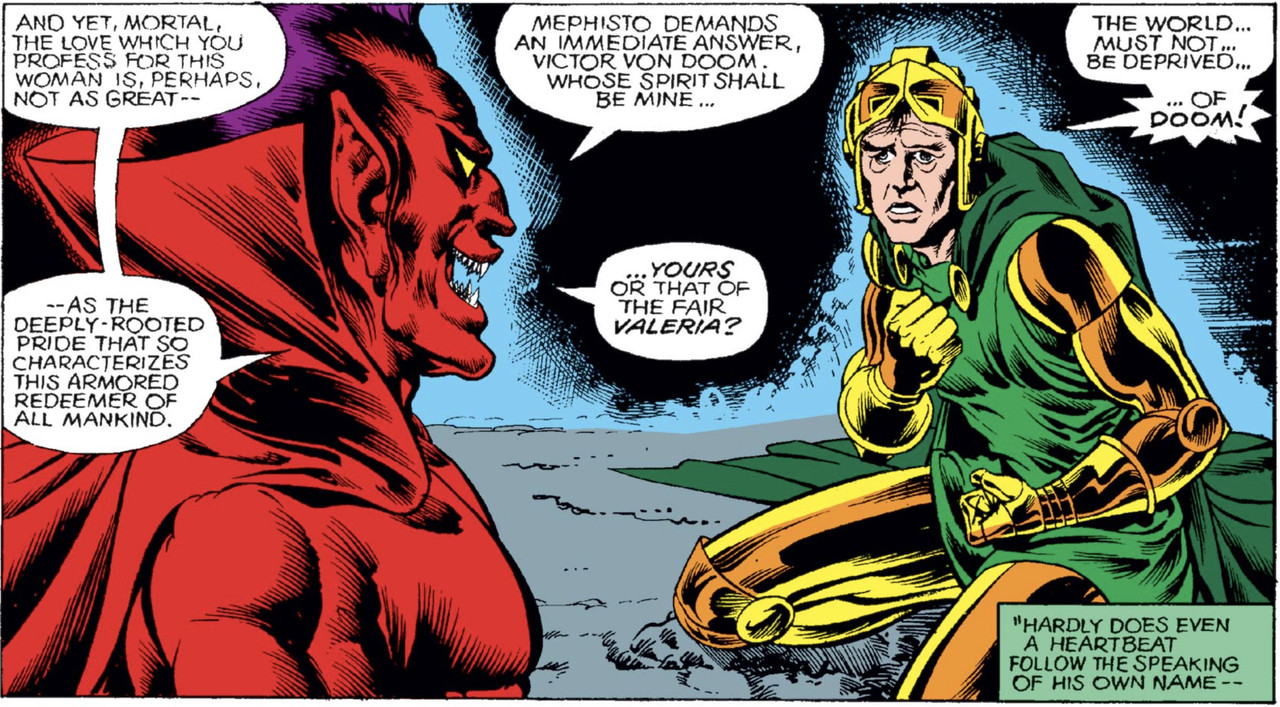
Doom chooses to sacrifice Valeria.
Is this heroism? The title of the issue may imply that it is. After depriving himself of his greatest love, and forcing himself to endure the torture of knowing he damned her soul, Doom continues to apply his intellect to the betterment of mankind. While Doom is avoiding an eternity in hell for himself, his presence in the world will undoubtedly be more valuable than that of Valeria. She is nothing more than a pawn, just like everyone else. Doom spends the story’s end fruitlessly attempting to rescue Valeria’s soul each year, clearly haunted by his decision.
Or is this selfishness? When asked to choose between himself and his love, Doom chooses himself. Is that truly because he imagines himself as an indispensable architect of a better tomorrow? If so, is he right? Perhaps the title solely implies that this is the most heroic Doom could ever be.
Mommy Issues
Doom’s love for his mother, Cynthia Von Doom, set him on the path to becoming Doctor Doom. Her soul, trapped by Mephisto, was the reason Doom was so eager to see his college experiments realized.
Doom would eventually free his mother’s soul in 1989, with the help of Doctor Strange, master of the mystic arts. Doom was runner-up for the title of Sorcerer Supreme, bested only by Doctor Strange. It’s important to note that Doom isn’t just a brilliant inventor, he’s one of the most gifted magicians alive. After receiving the title of “Sorcerer Supreme,” Strange was instructed but the magic gods to grant one request of Doom’s. Doom requested Strange’s assistance in rescuing his mother’s soul.
Doom would free his mother by betraying Strange to please Mephisto, trapping Strange in the underworld. Mephisto frees Cynthia’s soul, honoring his deal, but upon learning what her son had done to free her, Cynthia refuses to be freed, disavowing her son, while Victor tries to explain his actions.
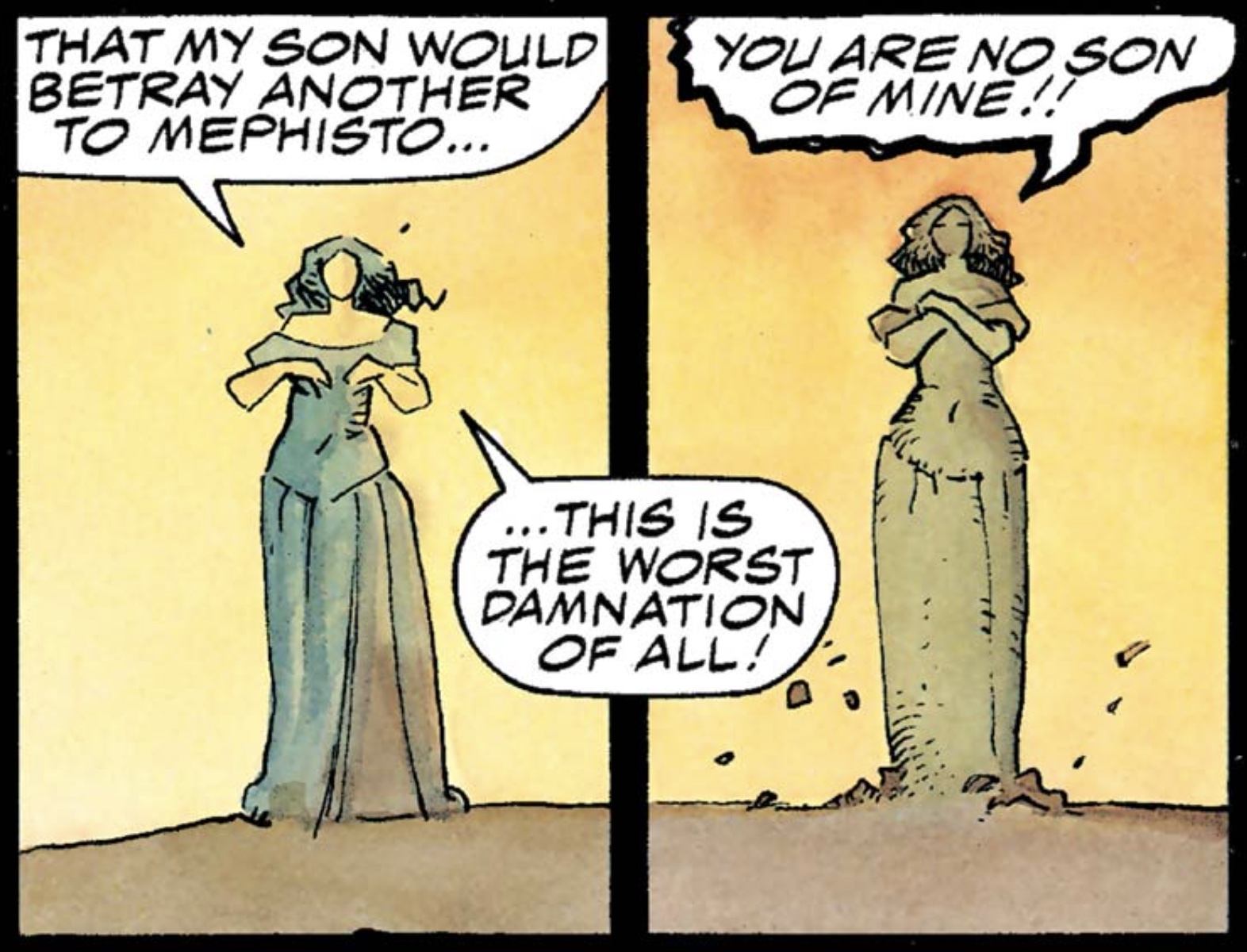
Doom, unbeknownst to Strange and Cynthia, had planted a device on Strange, which he used to free him. Cynthia, having renounced Victor, had redeemed her soul.
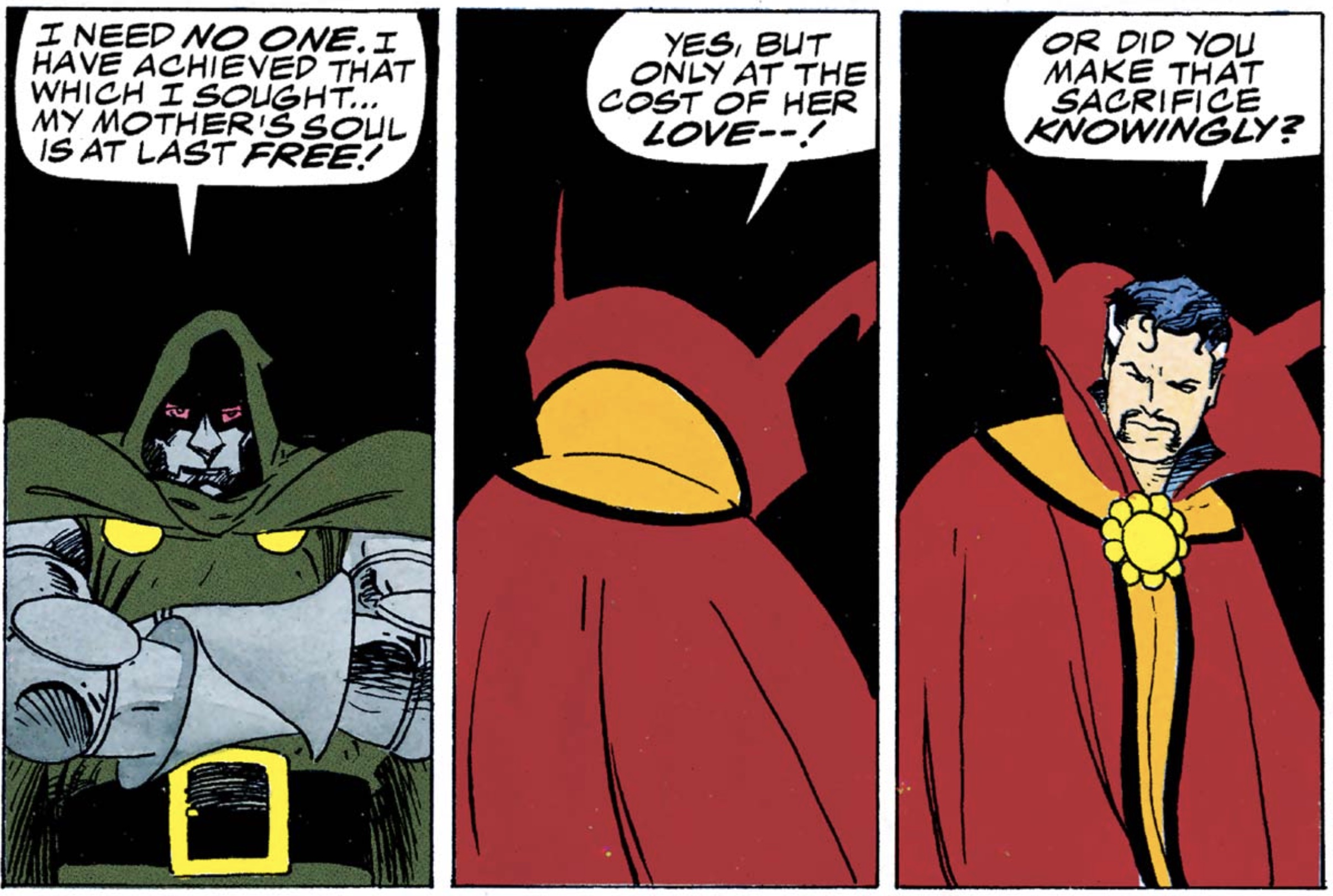
Did Doom expect his mother to renounce him? Or did he hope to free her, then free Strange, but she didn’t give him a chance to explain?
Either way, Doom seems satisfied with the outcome.
Cynthia would never know her son’s betrayal was a ruse. Her soul was no longer in the clutches of Mephisto, but Victor had lost her love. Does this sacrifice make Doom a hero? Would Doom have sacrificed his mother the same way he sacrificed Valeria?
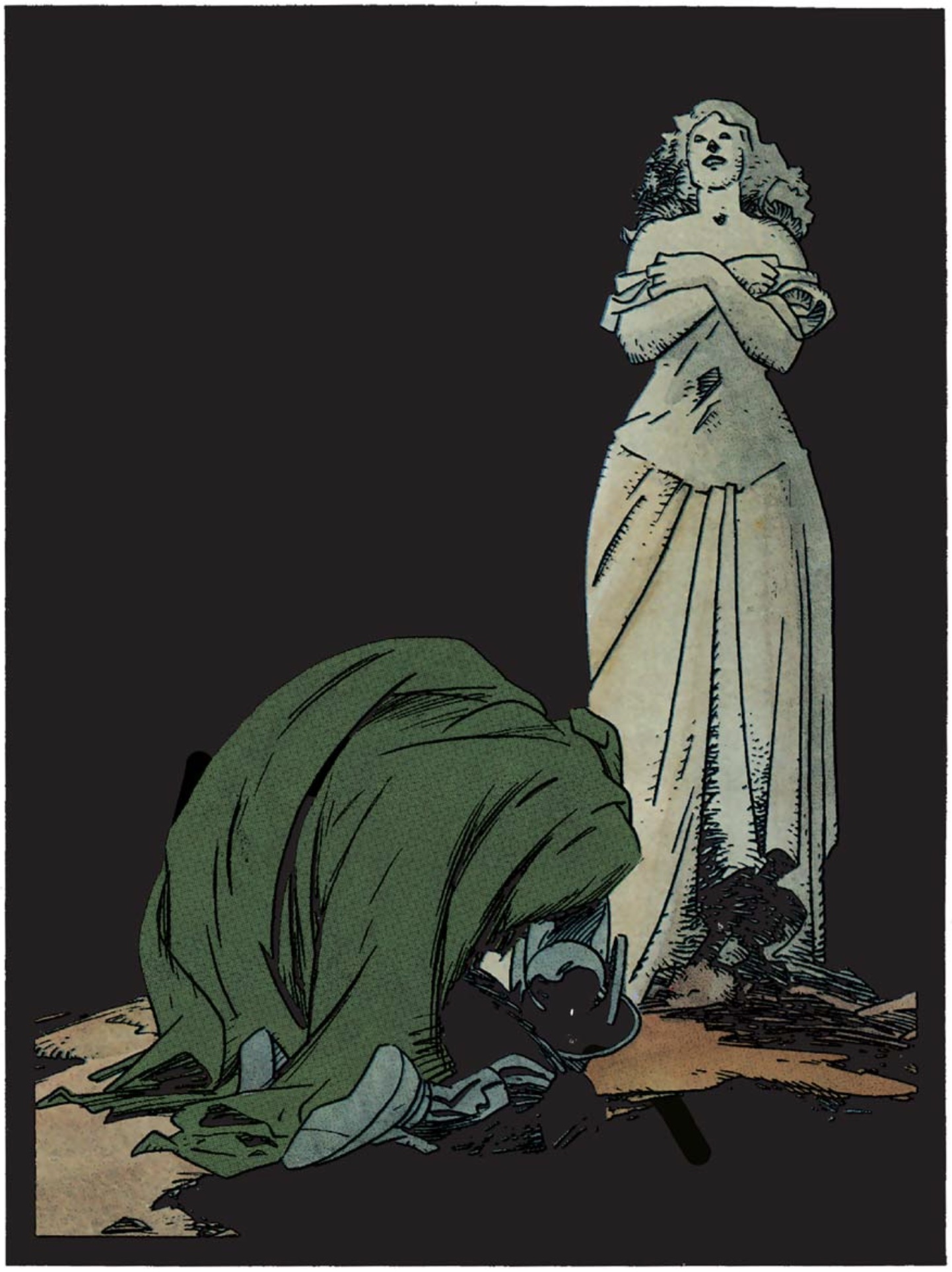
The Antlion Incident
Earth’s scientists, including Reed Richards, have devised a device, called the “Antlion Station,” to mitigate climate change but only Doom can see that it will end in disaster. After an attack destabilizes the Antlion Station on the moon, Doom takes it upon himself to correct the error created by his rival.
After sharing a strategy with the world that would end the Antlion threat he receives a call from Reed Richards.
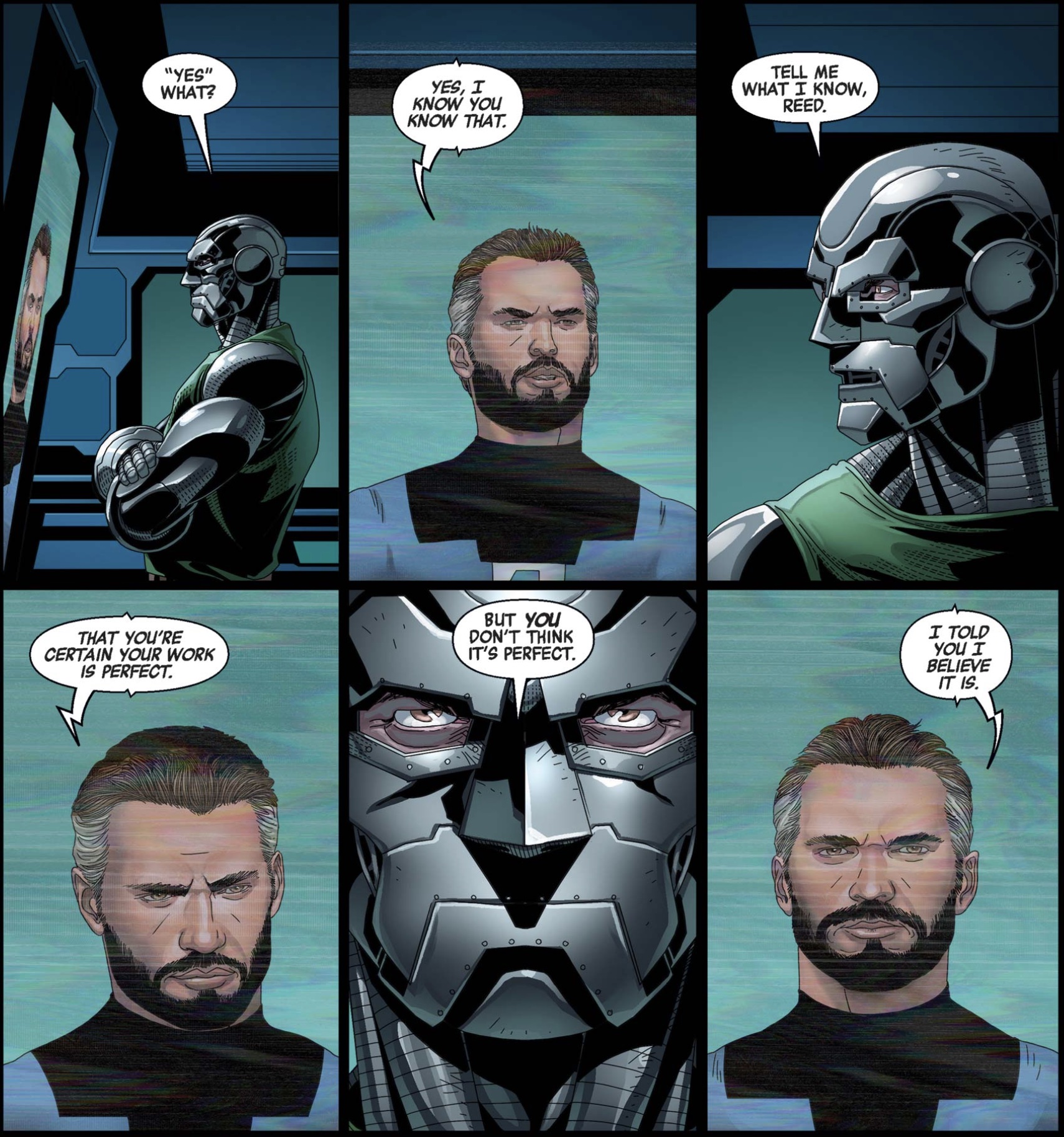
Ironically, Richards’ confirmation that Doom’s calculations are correct, sends Doom into a rage. Doom could never be mature enough to wish Reed luck, so therefore Reed couldn’t be mature enough to do it for Victor. What’s the catch?
Obviously, Richards has noticed a flaw in Doom’s calculations, and wants Doom to fail. In an inversion of Doom’s origin, Reed’s lack of correction causes Doom to doubt himself.

While Doom does successfully destroy the malfunctioning Antlion Station, he does so too fast, adjusting his math at the last minute to account for Richards’ deceit.
A portal open from the exploding Antlion station, and suddenly Doom finds himself transported to an alternate reality that had been taunting him in visions.
In this new world, Doom’s face is healed and the world is a utopia. Floored by the success of his alternate self, Doom makes several shocking decisions.
First Doom states his wish to learn, implying there is something that Doom does not know.
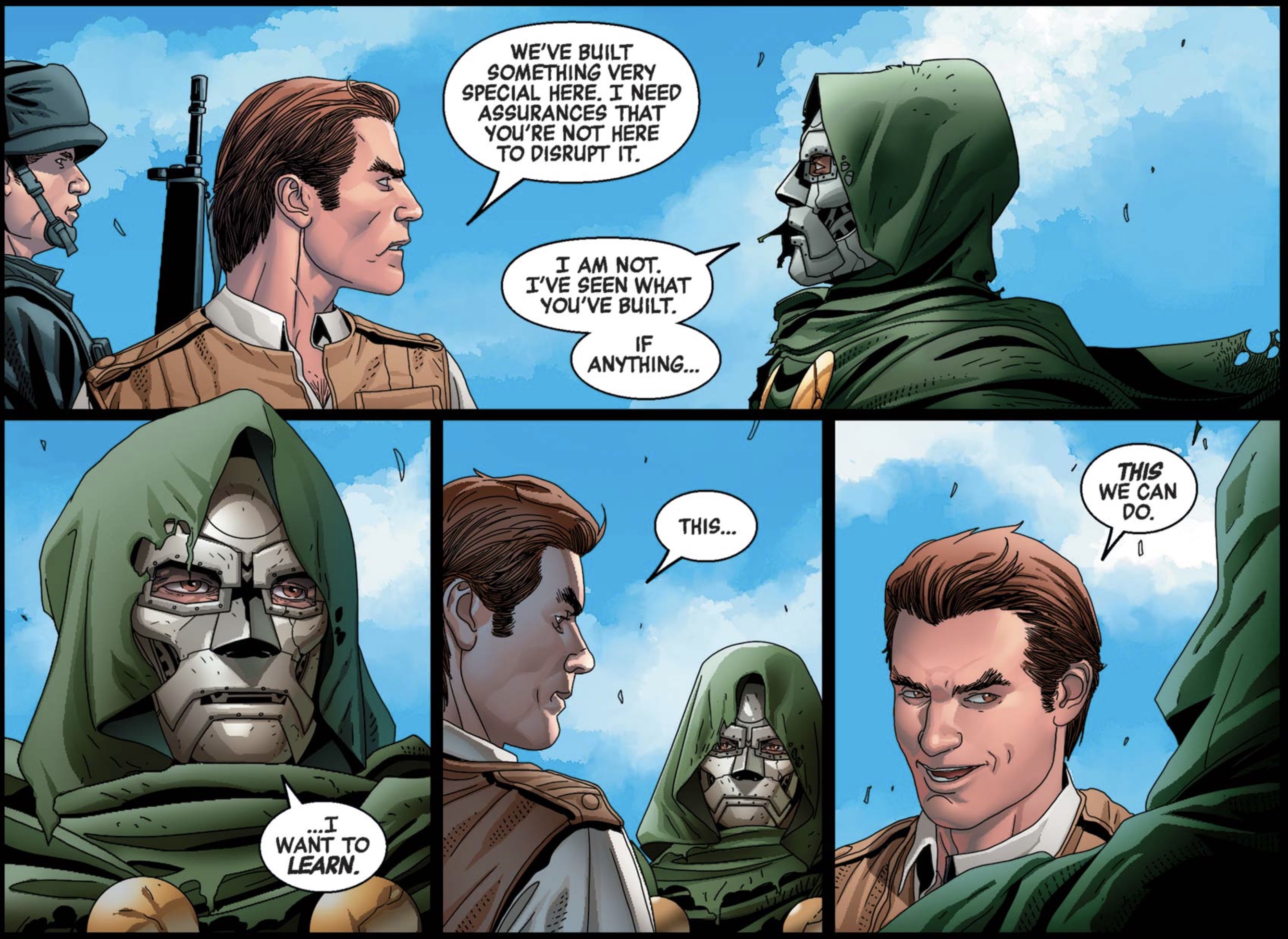
Second, Doom says…

Doom could never be wrong.
Doom learns that his alternate self, although in large part responsible for the “saving” of the world, doesn’t rule it. Even this, he accepts with hesitation.
Finally, Doom’s alternate self reveals how he solved everything.

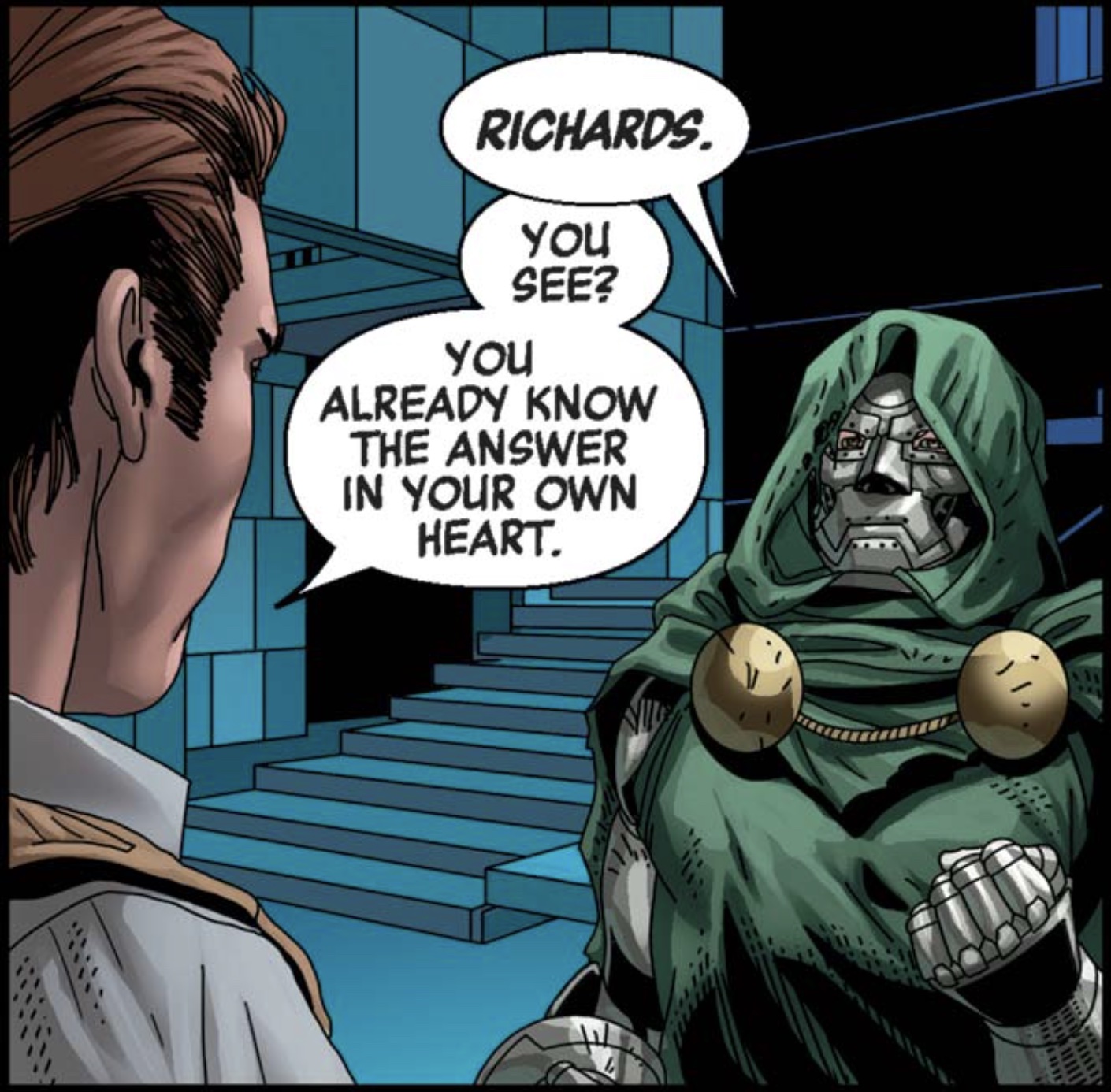
Richards is evil, vain, self-centered, and egotistical, everything Doom is not. How could Doom succeed if he were to open himself up to Richards? Unless… Unless, Doom is wrong about him. Unless, Doom was wrong in the calculations, which would have produced his scarring in college. But Doom is never wrong. This whole universe is wrong. A final insult to Doom’s armor prompts a striking reaction from Doom.
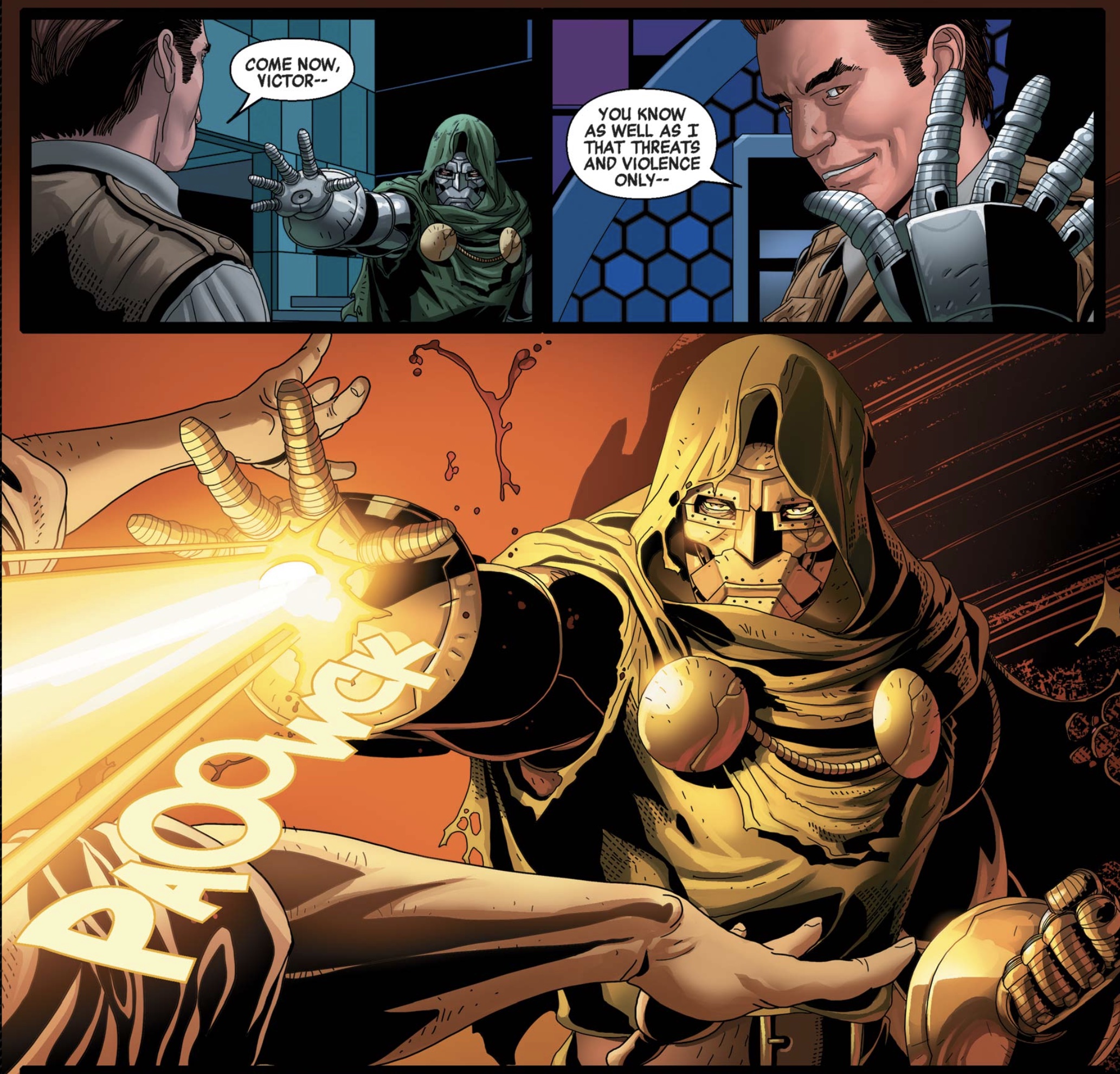
So Doom does the only logical thing he can do, he destroys the universe and all of it’s inhabitants. If this universe is allowed to exist, then everything Doom turned himself into can be nothing more than a lie he uses to delude himself. To hide from what he has become. And Doom does not hide.
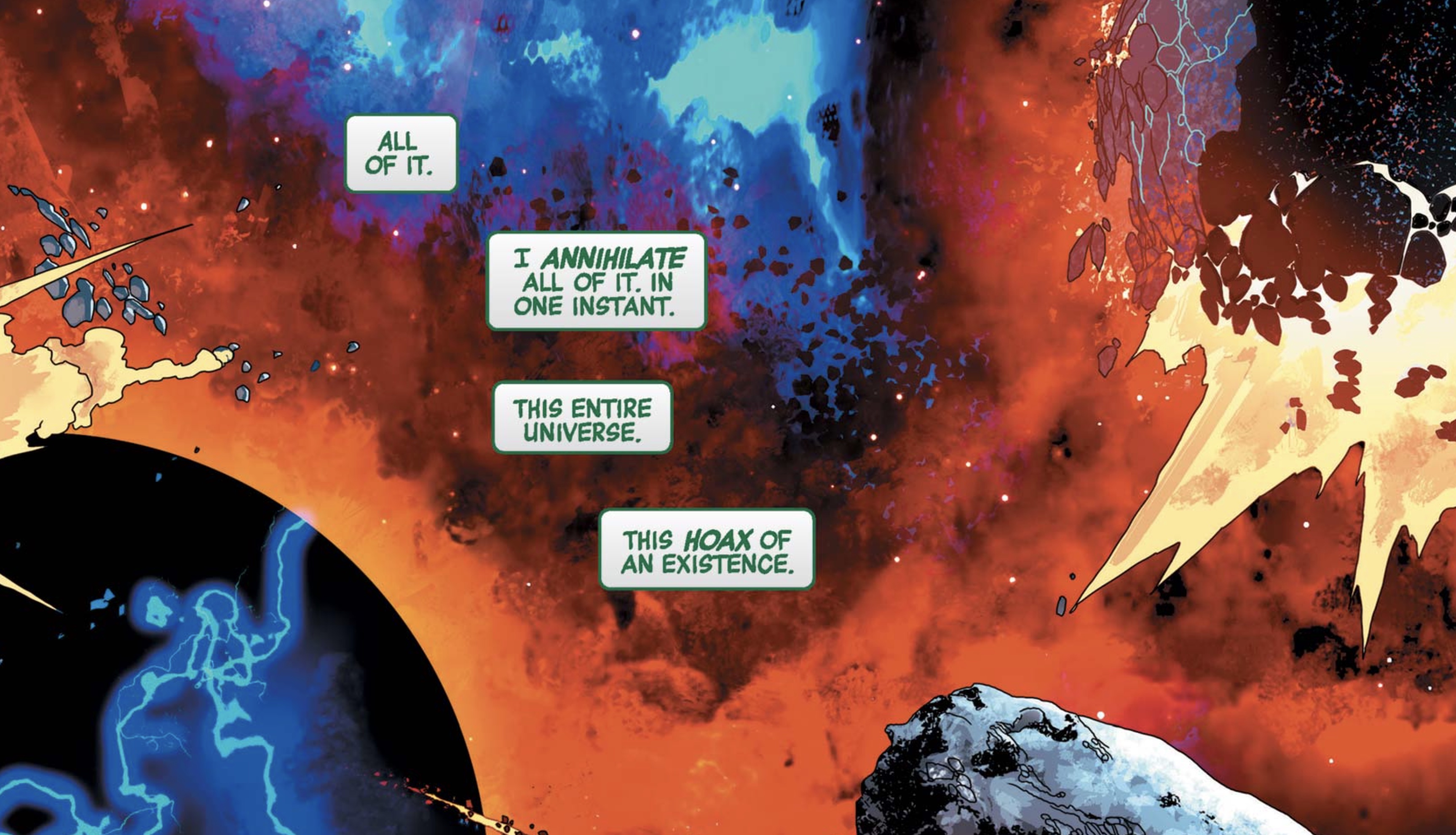
Fantastic Fifth
In recent years, Doom’s characterization has shifted. After delivering Sue Storm’s second child, and naming her “Valeria” after his childhood girlfriend, (this was before he killed and skinned said girlfriend) he befriends the child and keeps her under his protection. Doom attended Human Torch’s funeral (he got better). Doom has even worked with the Fantastic Four on occasion. Their relationship bordered so closely on friendship that Doom invited them to his wedding. (Human Torch then accidentally sleeps with Doom’s bride the night before their wedding, whoopsies!)
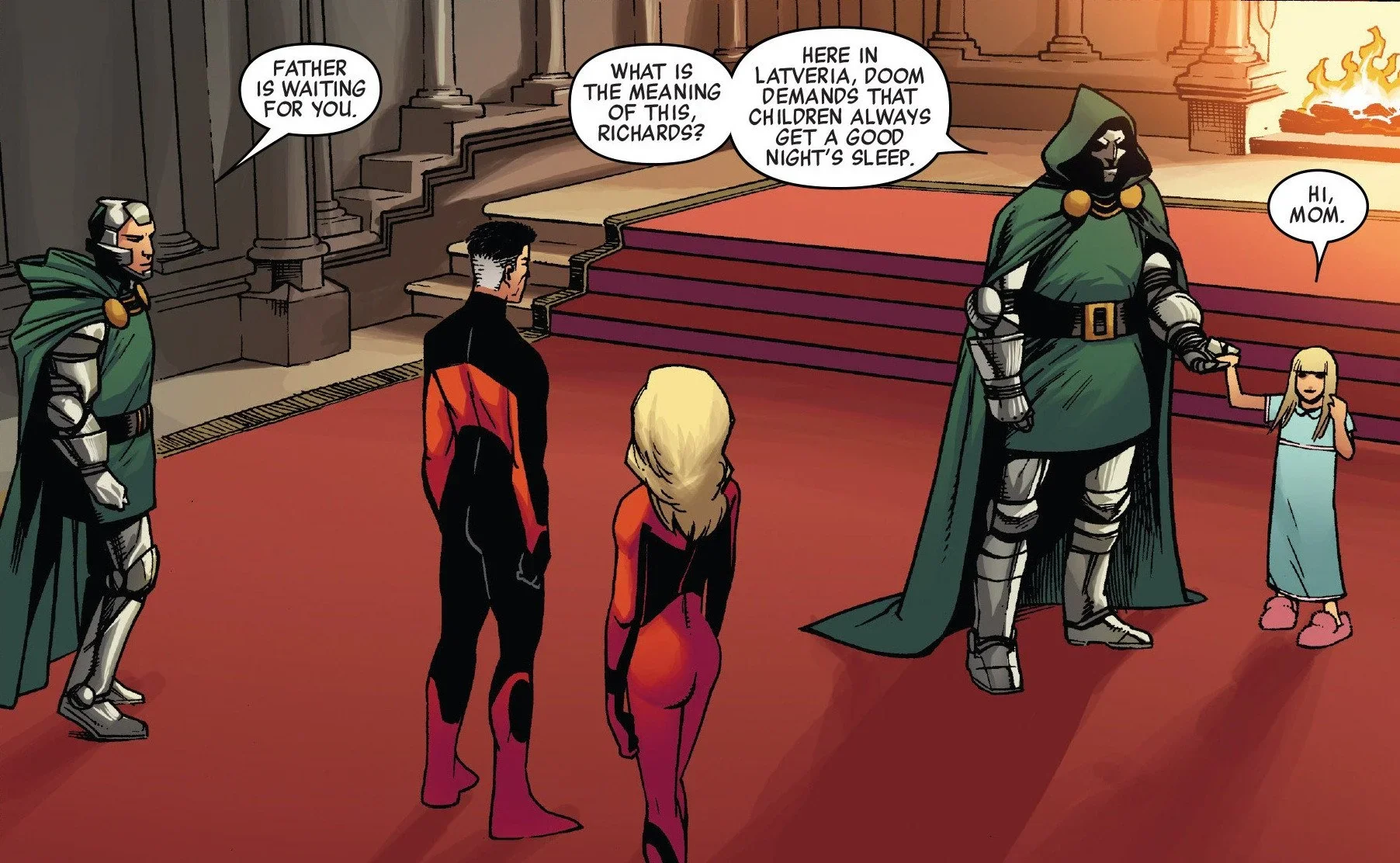
Is this still the same Doom who turned his ex-girlfriend into a skin-suit to spite the Fantastic Four?
After many writers inherit the same story, it essentially becomes licensed fan-fiction. Despite this, most of Doom’s characterization has stayed remarkably similar over the years. His ego, vanity, intelligence, and the fact that he refers to himself in the third-person have all remained intact. What shifts from story to story is how evil he is.
Does a watered-down Doom really have the same bite and appeal as an evil Doom? Is it fair to turn a character who was (probably) inspired by real dictators into a heroic figure?
That depends on your perspective. The panel above is quite funny, but does it trade character for humor? What do we do in comics when all the villains become heroes?
The Movies
Doctor Doom from the movies sucks!
In the 2005 Fantastic Four movie, he’s an American businessman with electricity powers gained on the same mission that gave the four their powers. Also, the accident turns his skin into armor, instead of him applying it himself.
Fantastic Four (2005) earned a 28% on Rotten Tomatoes.
In the 2015 Fantastic Four movie, he’s an American programmer who get’s telekinetic powers on the same mission that gave the four their powers. The accident turns his skin into armor, instead of him applying it himself.
Fantastic Four (2015) earned a 9% on Rotten Tomatoes.
In 2024, it was announced that Doom would finally be entering the Marvel Cinematic Universe. Doom will be played by Robert Downey Jr., an American actor who is also known for playing Iron Man. It is currently unknown if this version of Doom will be an alternate universe version of Iron Man, who is an American businessman and inventor. Consider me skeptical.
So Here’s The Thing (part 2)
Ben Grimm also attended college with Reed and Doom before they all gained their powers. Ben was a football star and one day, while practicing, Ben bumped into Doom who was carrying some paint.

The ultraviolet paint stained Ben’s clothes and started to glow at a party later. Ben, in turn, decides to pull a prank on Doom and breaks into Doom’s room. While tampering with Doom’s experiment, Ben notices glowing mystical symbols in Doom’s room and smudges one on the wall.
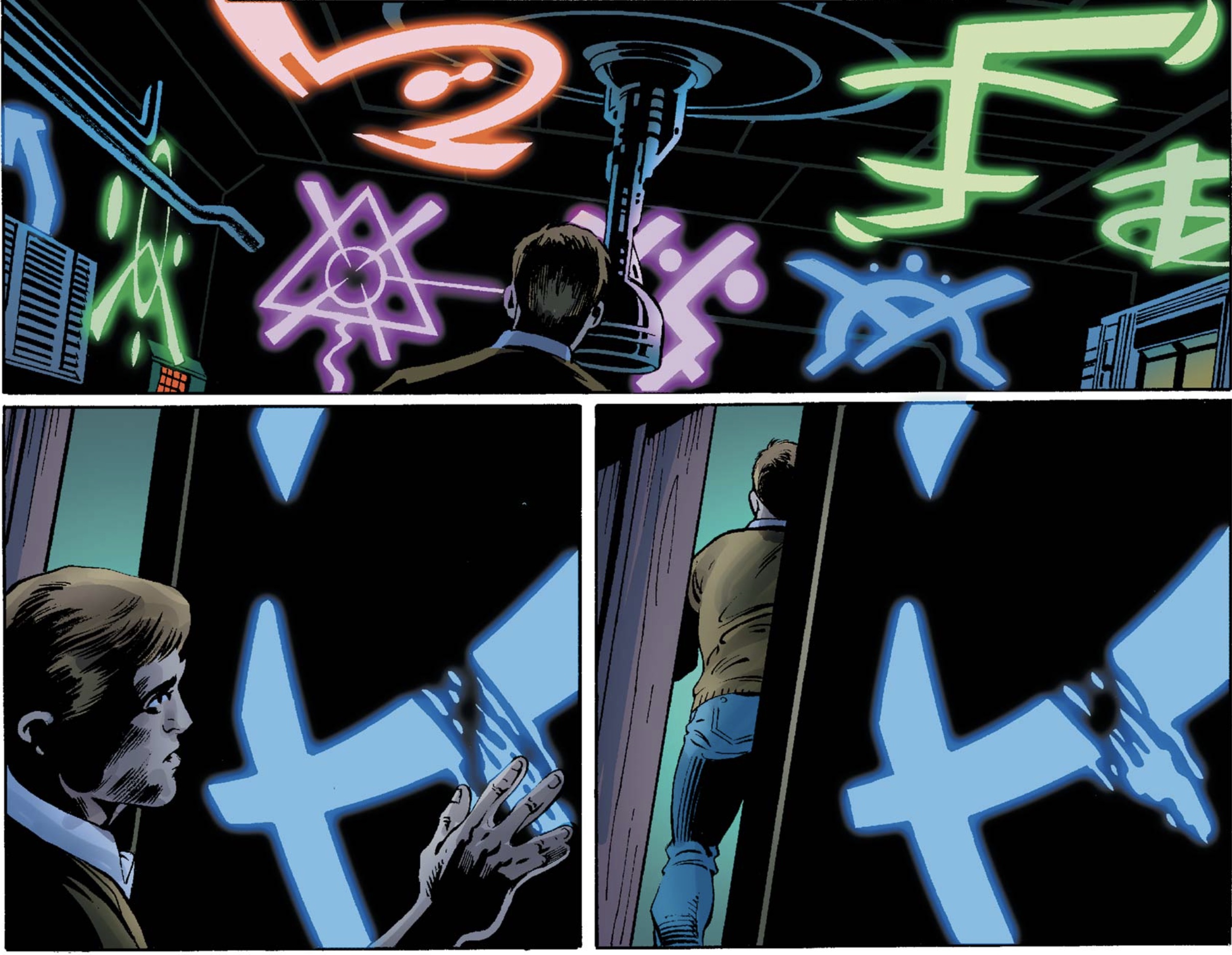
Did Ben Grimm accidentally cause Doom’s experiment to fail? It’s possible that Reed’s couldn’t understand Doom’s math because he couldn’t understand the mystical side of Doom’s work, causing him to believe that Doom had errors in his math. Reed has often struggled to understand magic. Still, the omniscient narrator in Lee and Kirby’s version of Doom’s origin says that Reed had noticed an actual error. Perhaps Ben Grimm isn’t responsible for Doom’s disfigurement after all. Maybe, even without Grimm’s interference the experiment would have failed.
Doom’s origin shows the reader that his fatal flaw is his inability to accept when he may be wrong, but maybe he wasn’t wrong. Maybe he was sabotaged.
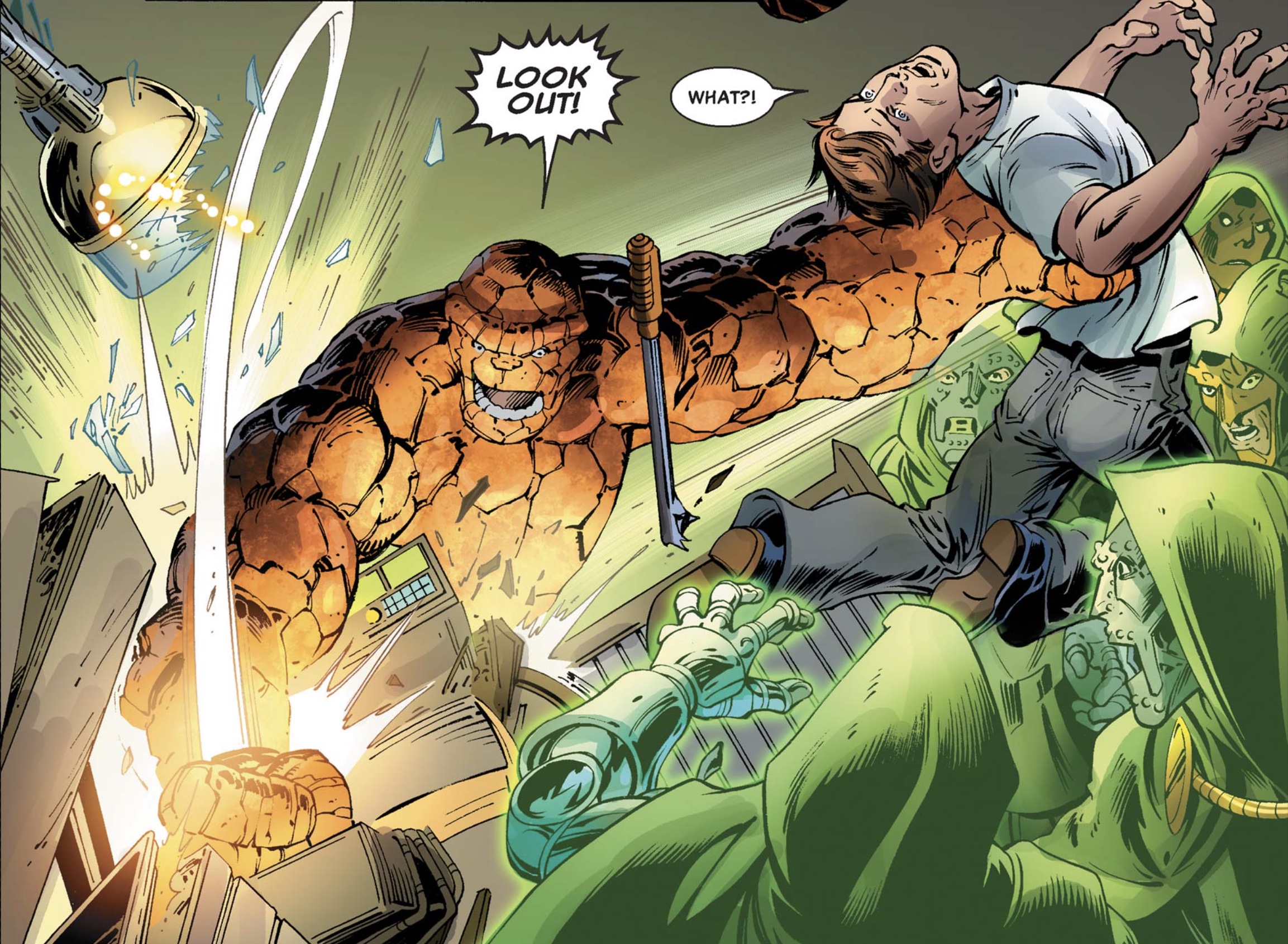
Ben Grimm, years later, returns to the past with Reed, and despite the fact that he was commanded not to interfere, Grimm destroys Doom’s experiment before it can blow up in Doom’s face.
In a shock twist, Doom was being watched, by a swarm of Doctor Dooms from the future, who were all gathered to witness Doom’s “nativity.” The other Doom’s spurred to action by The Thing’s interference, also fully materialize in the past to help ensure the nativity goes according to plan. Reed tries to tell Victor that he doesn’t have to become Doctor Doom.
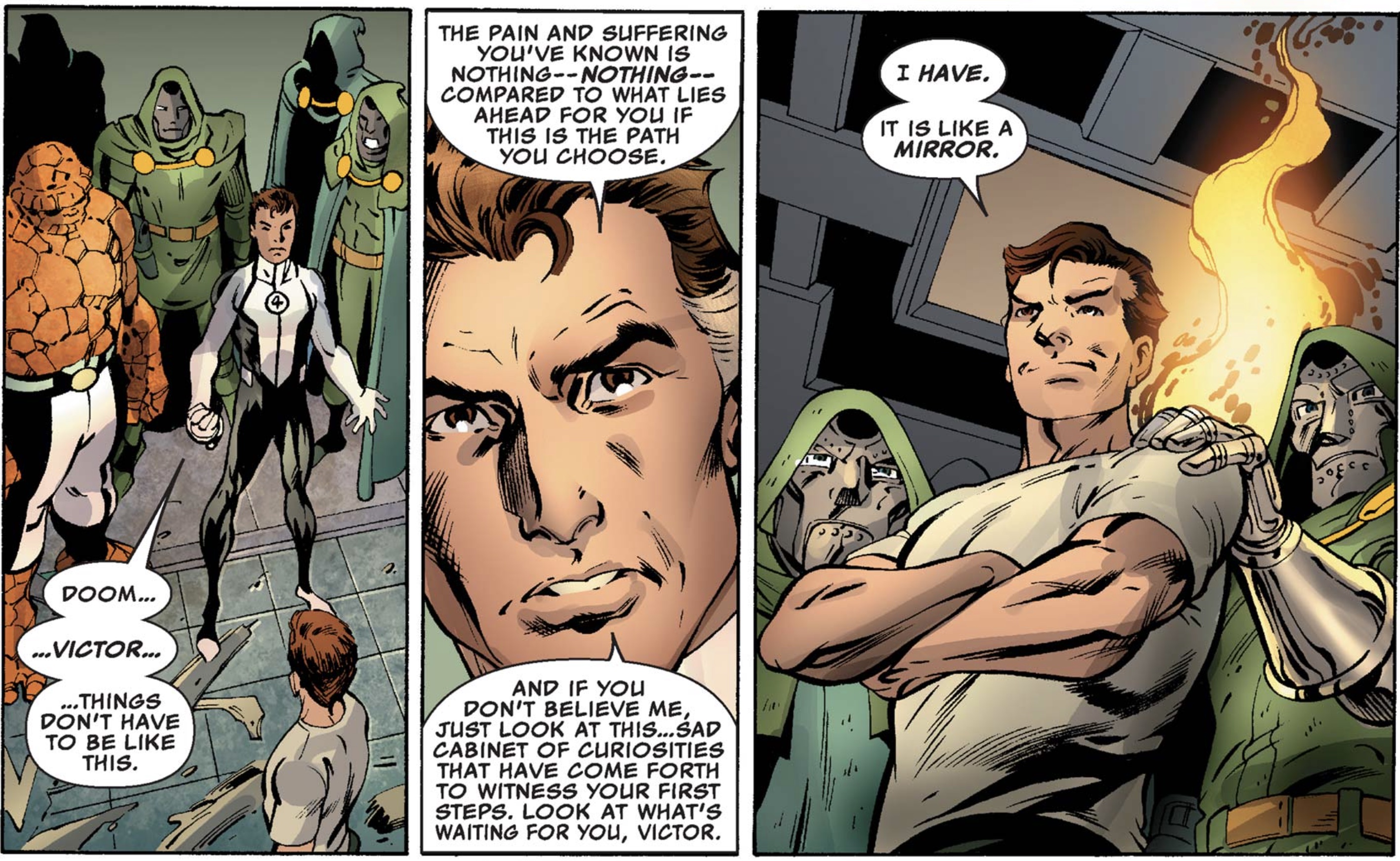
The nativity continues. This time, it is the future Dooms who apply the mask, further emphasizing how responsible Doom is for his own failings.
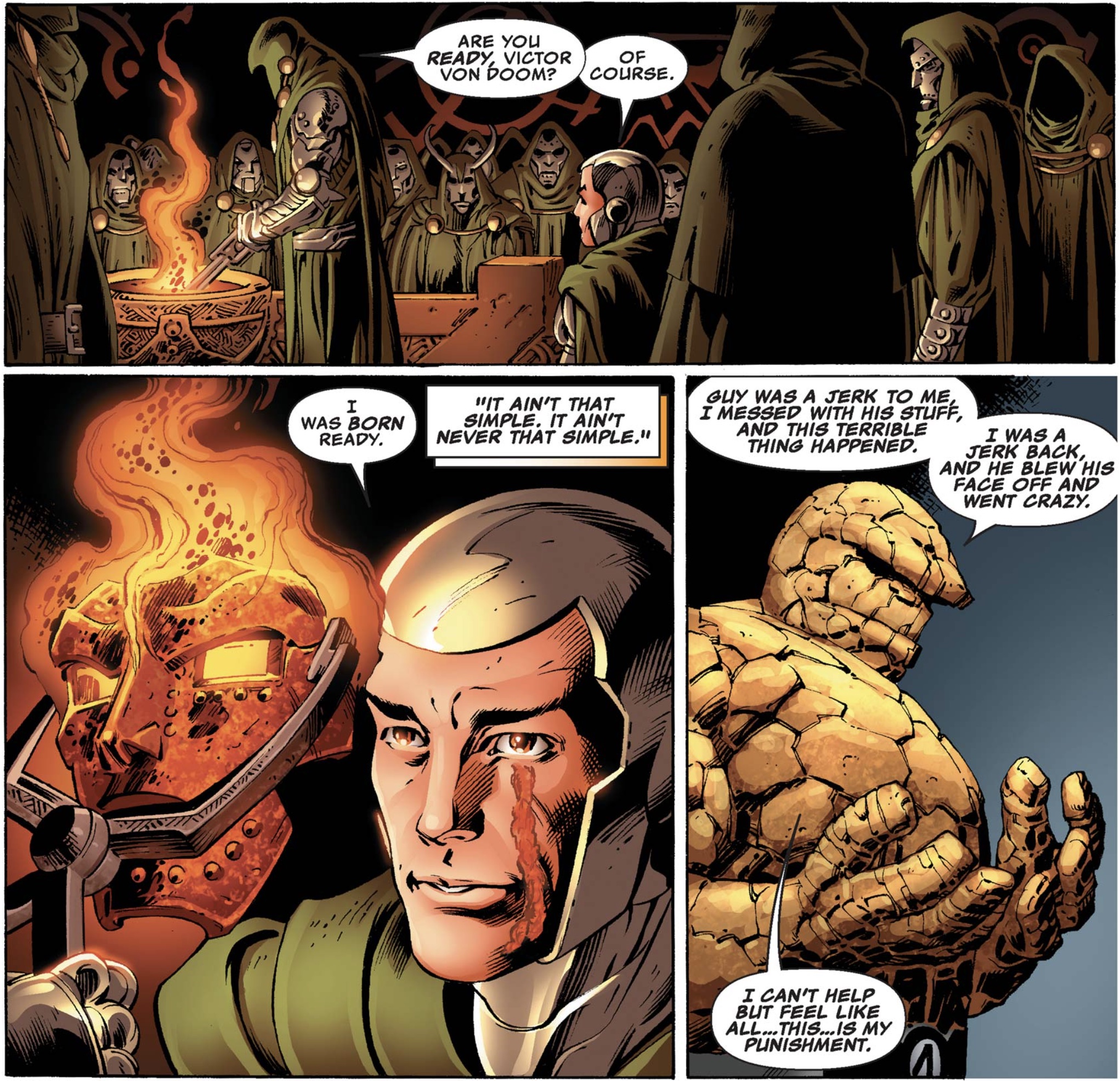
The idea of this story is simple. Nobody is to blame for who Doom is, it was always his nature.
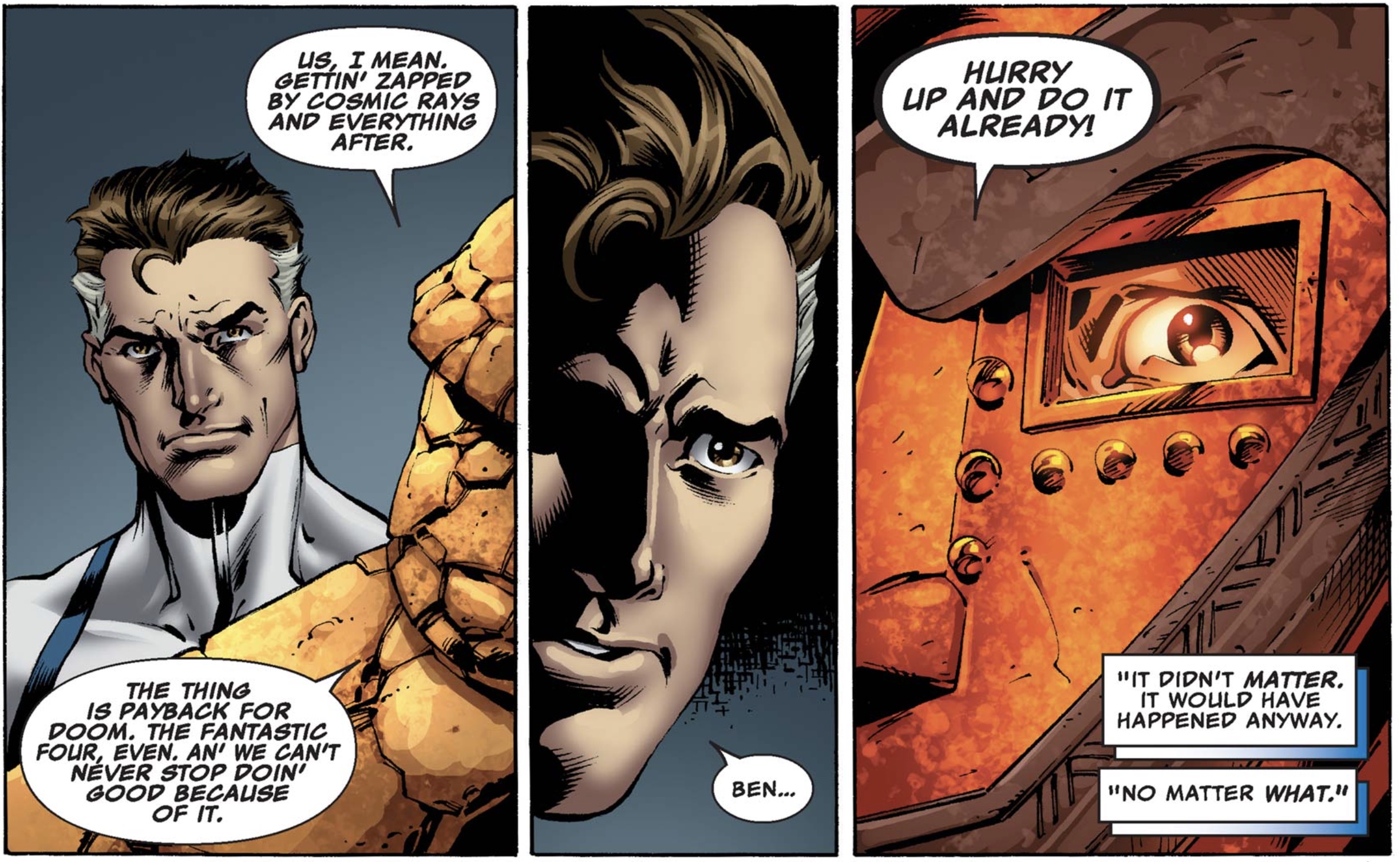
Who is Doctor Doom?
Doctor Doom is vanity. His obsession over external grievances are meant to mask his internal dissatisfaction. His arrogance, while somewhat founded in his great intellect and willpower, is overstated, to mask his deep insecurity. And yet, Doom would never describe himself this way, whether he feels it to be true or not. Doom’s character reveals itself in the parts of himself he tries to hide. Everything Doom refuses to see in himself, he reflects onto Reed Richards. The irony is, Doom’s hatred for Reed is just another way for him to hate himself.
Comic book canon is long, complicated, and often self-contradictory. Many will decide to disregard certain stories or plot-points, believing them to mischaracterize or mistreat previous material. This is absolutely fair. Across the decades of history, certain things won’t add up to a cohesive whole. Realistically, the version of events you choose to believe is just as valid as anyone else’s. You can build your own Doctor Doom. Do you believe he scarred his own face while he was god? Did Doom expect his mother to disavow him before he could explain his full plan? Is Doom capable of healing the world if we would just give him a chance? The Doom you design may even say something about you.
“Unthinkable,” (skin armor) the story at the start of this writing, is often highlighted as one that mischaracterizes Doom. Detractors will cite Doom’s excessive cruelty and borderline dishonesty throughout the story. Whether you believe that is a valid version of Doom or not will indicate how you see his character. If Doom is a tragic, tortured, but ultimately good man, then Doom could never kill Valeria. If Doom is a pathetic, self-obsessed, and truly vindictive man, then yes, he is capable of such evil.
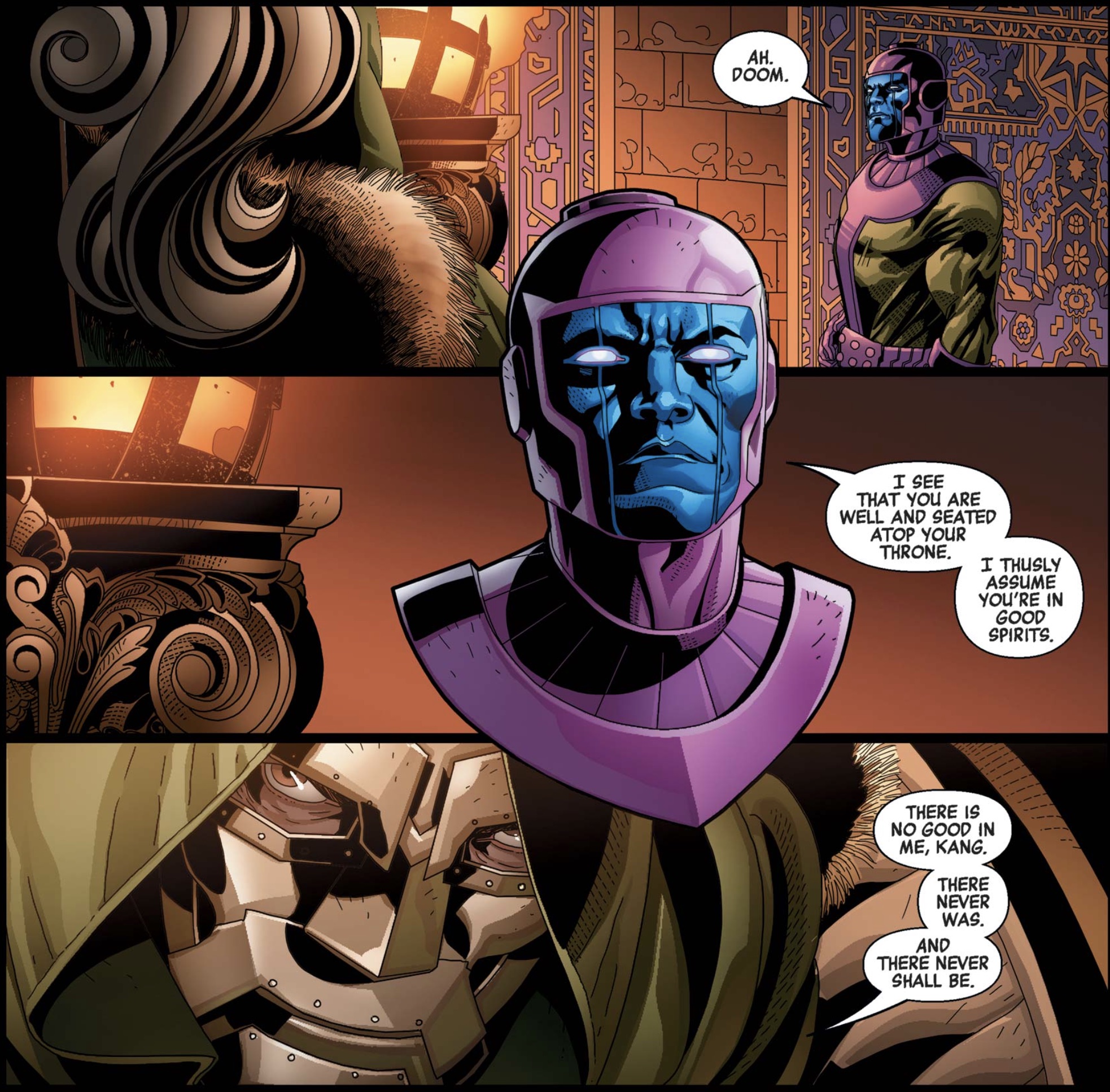
The more I read of Doom, the more I accept both sides to be true. Doom himself is a contradiction, built on self-loathing and self-adoration at the same time. Those ideas seem like opposites, but both start with the word “self.” In his mind Doom must be the best or the worst person on the planet, but Doom must exist on one extreme due to his obsession with himself. The scariest thing for Doom to admit, is that he isn’t alone because nobody can understand him, Doom is alone because he chooses to be. The way to truly best Doom is to envision him not as a hero or villain, but as simply a human being.

Recommended Reading
- Doctor Doom (2019) #1-10
- Doctor Strange/Doctor Doom: Triumph and Torment
- Fantastic Four (1996) #67-500
- Fantastic Four (2012) #9
- Fantastic Four (1961) #57-60
- Fantastic Four (1961) #258

